
About UsThe Numismatic Bibliomania Society is a non-profit organization devoted to the study and enjoyment of numismatic literature. For more information please see our web site at coinbooks.org SubscriptionsThose wishing to become new E-Sylum subscribers (or wishing to Unsubscribe) can go to the following web page link MembershipThere is a membership application available on the web site Membership Application To join, print the application and return it with your check to the address printed on the application. Membership is only $20 to addresses in the U.S., $25 for First Class mail, and $30 elsewhere. For those without web access, write to: David M. Sundman, Treasurer
AsylumFor Asylum mailing address changes and other membership questions, contact David at this email address: dsundman@LittletonCoin.com SubmissionsTo submit items for publication in The E-Sylum, just Reply to this message, or write to the Editor at this address: whomren@gmail.com BUY THE BOOK BEFORE THE COIN |
- WAYNE'S WORDS: THE E-SYLUM FEBRUARY 1, 2015
- SKLOW MAIL BID SALE #24 CLOSES FEBRUARY 7, 2015
- BALDWIN'S OFFER NUMISMATIC LITERATURE
- NEW BOOK: OBSOLETE CURRENCY OF ALLEGHENY COUNTY
- NEW BOOK: COIN OF THE YEAR
- NEW BOOK: THE ECUADOR REGISTER PART III: 20 SUCRES
- BOOK REVIEW: PLEASURE & PROFIT
- MARGO RUSSELL 1919-2015
- SS CENTRAL AMERICA FINDER TOMMY THOMPSON FOUND
- THIS FINAL JOURNEY OF THE SS CENTRAL AMERICA
- THE HISTORY OF FOOD STAMP CHANGE TOKENS
- NOTES FROM E-SYLUM READERS: FEBRUARY 1, 2015
- HELP SOUGHT FOR WHITMAN OBSOLETE PAPER MONEY PROJECT
- PCGS UNVEILS DIGITAL COIN ALBUM
- UPDATE: NUMISMATIST ISSUES STILL SOUGHT
- MORE ON 19TH-CENTURY NUMISMATIST WARREN GEE
- MORE ON H.E. STONE AND PHILA-NUMIS
- A.M. SMITH'S ILLUSTRATED HISTORY OF THE U.S. MINT
- CANADIAN PASSPORT FEATURES ULTRAVIOLET LIGHT IMAGES
- COINS FOR THE 50TH ANNIVERSARY OF THE CANADIAN FLAG
- STARCK CONTRASTS: LIMA SHILLING, KARSHAPANA COIN
- CIVIL WAR SUTLER SCRIP IN STACKS BOWERS 2015 AMERICANA SALE
- GORNY & MOSCH AUCTION SALES 228-230
- COIN SAVED SOLDIER'S LIFE AT BATTLE OF WATERLOO
- GOLD NUGGETS STOLEN FROM WELLS FARGO HISTORY MUSEUM
- MASSIVE FIRE AT A MOSCOW SCIENCE LIBRARY
- ROYAL MINT'S 5P AND 10P COINS STILL CAUSING PROBLEMS
- NEW BRITISH ONE POUND COIN VEXES VENDING INDUSTRY
- COUNTERFEIT DETECTION BY BITING
- HEY KIDS, WANT TO COUNTERFEIT MONEY?
- FAKE BANKNOTE GIVES WOMAN A HEART ATTACK
- THE GROUNDHOG DAY MARATHON MEDAL
- FEATURED WEB PAGE: CURRENCY PATENTS
Click here to access the complete archive
To comment or submit articles, reply to whomren@gmail.com
WAYNE'S WORDS: THE E-SYLUM FEBRUARY 1, 2015

New subscribers this week include: Tim Harris, Chester Sullivan, Jerry Bors and Vanoy Welch. Welcome aboard! We now have 1,820 subscribers.
This week we open with a reminder for David Sklow's literature sale, new literature offerings from Baldwin's, three new books, one review and tributes to former Coin World editor Margo Russell.
Other topics include the finding of Tommy Thompson, the history and collecting of food stamp change tokens, numismatists Phares O. Sigler, Warren Gee and H.E. Stone, the new PCGS digital coin album, civil War sutler scrip, a brazen robbery at the Wells Fargo museum, the U.S. Colored Cavalry, and currency patents.
To learn more about medallions from Aboukir, the Canadian flag and passport, Pittsburgh obsolete notes, "one of the most intelligent fugitives ever sought by the U.S. Marshals," the Plasco Company in LaCrosse, Wisconsin, Johnson Island and the unusable coin of William Wood, read on. Have a great week, everyone!
Wayne Homren
Editor, The E-Sylum
SKLOW MAIL BID SALE #24 CLOSES FEBRUARY 7, 2015
Fellow Bibliomaniacs!
Only one week left to submit your bids in Mail bid sale # 24.
David Sklow-Fine Numismatic Books will have its MBS # 24 closing on February 7, 2015 at 8 PM. Bidding will be via Email, Telephone, Fax and Mail, bids will be accepted that are received by Email, Fax or Telephone message up to midnight on closing day. There are NO changes to the terms of sale. The sale consists of over 1000 lots of a well diversified nature, Featuring selections from the libraries and collections of: Daniel M. Byrne, Orville Grady, the late F. Gordon Frost and the late Harold Shaw Bareford, a paper money expert of great renown, Jan Monroe, John Phipps, the Coconut Collector, "Big Jim", Remy Bourne, that guy from Chicago, Cecil Webster, Q. David Bowers and several others.... and of course some special things from Myron Xenos .
The catalog is fully indexed, but, please be sure to check every page, so you will not miss those items you are really looking to add to your library!
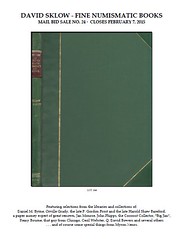 Good luck, bid early and bid often!
Good luck, bid early and bid often!
Thank you,
David
David Sklow-Fine Numismatic Books
P.O. Box 6321
Colorado Springs, CO 80934
PH: 719-302-5686
FAX: 719-302-4933
Email: numismaticbooks@aol.com
Web Site: FineNumismaticBooks.com
BALDWIN'S OFFER NUMISMATIC LITERATURE
Medallions from Aboukir
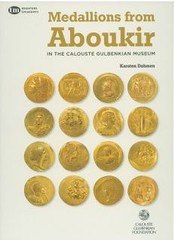 Dahmen, K. Medallions from Aboukir in the Calouste Gulbenkian Museum. Calouste Gulbenkian Museum, Portugal, 2013. 90 pages, high quality colour
illustrations throughout. Card covers.
Dahmen, K. Medallions from Aboukir in the Calouste Gulbenkian Museum. Calouste Gulbenkian Museum, Portugal, 2013. 90 pages, high quality colour
illustrations throughout. Card covers.
The Calouste Gulbenkian Museum possesses many treasures, but the 11 gold medallions from a hoard discovered in 1902 in Egypt constitute a remarkable example of ancient art and first hand source of Alexander related iconography. Of the original 20 medallions, Calouste S. Gulbenkian managed to collect 11, thus making Lisbon today the main repository of these pieces. They are the only such medallions in gold which have survived from the Roman period.
In contrast to other medallions in precious metals, they are not based on a defined coin standard, and cannot be considered multiples of regular aurei or solidi. In contrast, the Aboukir medallions are of diverse weights, possess a varying non–coin like fineness, and most importantly they are not products of any official Roman mint. In addition, they bear Greek, not Latin legends, naming the king Alexander, and offer a fascinating insight into a highly elaborate iconographic language telling the story and legend of Alexander the Great (356–323 BC) and the appreciation of him in the Roman period. Fittingly enough, the only Roman emperor depicted on these medallions is Caracalla, who himself was (in)famous for his very personal ‘Alexander-mania’.
For more information or to order, see:
www.baldwin.co.uk/medallions-from-aboukir-in-the-gulbenkian-museum.html
The Art and Craft of Coinmaking
 Cooper, D. R. The Art and Craft of Coinmaking. A History of Minting Technology. London, 1988. Quarto, pp.
264, illustrations throughout. Original boards. Top edge dusty, contents basically fine but evidently stored at some point in a damp environment and
somewhat affected. A fascinating book written by the retired Chief Engineer of the Royal Mint exploring the development of coin production since the
Renaissance. Highly sought after and long out of print.
Cooper, D. R. The Art and Craft of Coinmaking. A History of Minting Technology. London, 1988. Quarto, pp.
264, illustrations throughout. Original boards. Top edge dusty, contents basically fine but evidently stored at some point in a damp environment and
somewhat affected. A fascinating book written by the retired Chief Engineer of the Royal Mint exploring the development of coin production since the
Renaissance. Highly sought after and long out of print.
For more information or to order, see:
www.baldwin.co.uk/the-art-and-craft-of-coinmaking.html
Medallic Record of the Jacobite Movement
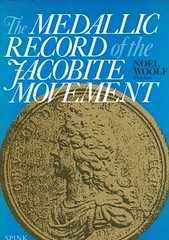 Woolfe, N. The Medallic Record of the Jacobite Movement. London, 1988. Large quarto, pp. (4), 160,
(1); b/w illustrations in the text. Original card covers. Errata list laid in. Minimal wear, almost as new. The standard reference. Now out of print
and highly sought after.
Woolfe, N. The Medallic Record of the Jacobite Movement. London, 1988. Large quarto, pp. (4), 160,
(1); b/w illustrations in the text. Original card covers. Errata list laid in. Minimal wear, almost as new. The standard reference. Now out of print
and highly sought after.
For more information or to order, see:
www.baldwin.co.uk/the-medallic-record-of-the-jacobite-movement.html
To view the complete Baldwin's book catalog, see:
www.baldwin.co.uk/catalog/category/view/id/321
NEW BOOK: OBSOLETE CURRENCY OF ALLEGHENY COUNTY
Obsolete Currency, Scrip and Notes of Allegheny County, Pennsylvania
by Robert Liddell and Charles Culleiton
Card covered
Spiral bound
190 pages
$30 plus $6 for shipping and handling to U.S. addresses
Coauthor Charles 'Skip' Culleiton writes:
 The book on obsolete currency contains 190 pages with information and many photos of [1] Advertisement
Notes [2] Bank Currency [3] Clearing House [4] Commission Scrip [5] Government [Boroughs, Towns, Allegheny County) [6] Merchant Scrip [7] Railroads
[8] Satirical Notes [9] Schools [10] Turnpikes. It includes all known genuine, altered, raised and counterfeit notes. We accept checks or PayPal to
the following address:
The book on obsolete currency contains 190 pages with information and many photos of [1] Advertisement
Notes [2] Bank Currency [3] Clearing House [4] Commission Scrip [5] Government [Boroughs, Towns, Allegheny County) [6] Merchant Scrip [7] Railroads
[8] Satirical Notes [9] Schools [10] Turnpikes. It includes all known genuine, altered, raised and counterfeit notes. We accept checks or PayPal to
the following address:
Charles Culleiton
2830 Hastings Drive
Lower Burrell, PA 15068
skipcull@verizon.net
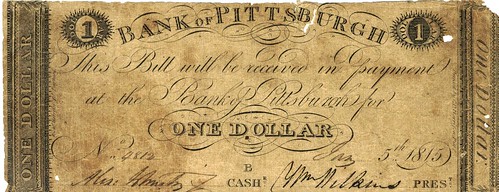
1815 Bank of Pittsburgh One Dollar note
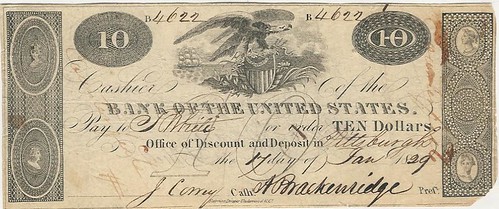
1829 Bank of the U.S. Pittsburgh Branch 10 Dollar note
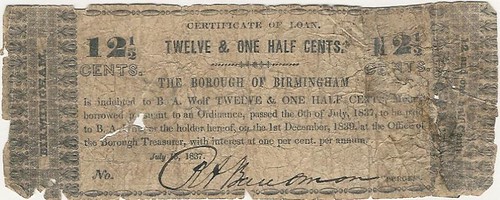
1837 Borough of Birmingham Pittsburgh 12 1/2 cent note

Great Lakes Coal Company Pittsburgh Clearing House note
NEW BOOK: COIN OF THE YEAR
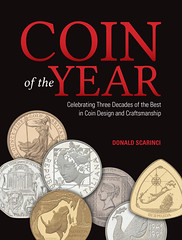 A
new book chronicling more than three decades of Coin of the Year Award winning coins will be released in June by Krause Publications.
A
new book chronicling more than three decades of Coin of the Year Award winning coins will be released in June by Krause Publications.
"Coin of the Year: Celebrating Three Decades of the Best in Coin Design and Craftsmanship" by Donald Scarinci celebrates the winners of this prestigious international contest honoring the very best in modern commemorative coinage.
The hardcover book covers the span of the awards up to 2015, featuring pictures and details of each year's winners. It includes an appendix in the back for collecting the coins.
Speaking at the 2015 Coin of the Year Award ceremony Jan. 31 in Berlin, Germany, Scarinci said the coins honored at the awards are studied, collected and appreciated for their beauty and importance to world numismatics.
"Just as we talk today with reverence for the beauty of the coinage of ancient Greece and Rome, when all of us in this room are dust, our distant descendants will someday talk with the same reverence about these coins, the nations, artists and people who created them," he said.
Appointed by the Secretary of the Treasury of the United States, Donald Scarinci serves on the Citizens Coinage Advisory Committee, which considers and approves all designs for American coinage. He is recognized internationally as an authority on medallic art and has written and spoken extensively on the subject.
First established in 1984 by World Coin News, the Coin of the Year has come to symbolize the year’s highest achievement in international numismatic design, artistic vision and craftsmanship.
To read the complete article, see:
Coin of the Year book honors three decades of awards
(www.numismaster.com/ta/numis/Article.jsp?ArticleId=28036)
NEW BOOK: THE ECUADOR REGISTER PART III: 20 SUCRES
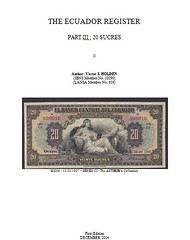 'THE ECUADOR REGISTER - AN ONGOING CENSUS OF THE BANKNOTES OF THE BANCO CENTRAL DEL ECUADOR ISSUED
FROM 1928 TO 1980 (together with a Listing of the post-1980 Issues which are not included in the Census)' - PART III : 20 SUCRES
'THE ECUADOR REGISTER - AN ONGOING CENSUS OF THE BANKNOTES OF THE BANCO CENTRAL DEL ECUADOR ISSUED
FROM 1928 TO 1980 (together with a Listing of the post-1980 Issues which are not included in the Census)' - PART III : 20 SUCRES
Full names of Signatories, where known, numbers of notes issued for each Date, Series and Signature Combination, together with URS ratings and all known Varieties and Errors.
Victor S. HOLDEN, 55 pages with comb binding, published by the author, Hong Kong, China, December 2014. List price US$50 (incl. S&H) available from the author at ecuadormanhk@yahoo.com.hk; payment via PayPal.
To read the earlier E-Sylum articles, see:
NEW BOOK: THE ECUADOR REGISTER PART 1: 5 SUCRES
(www.coinbooks.org/esylum_v17n25a04.html)
NEW BOOK: THE ECUADOR REGISTER PART II (www.coinbooks.org/esylum_v18n02a02.html)

BOOK REVIEW: PLEASURE & PROFIT
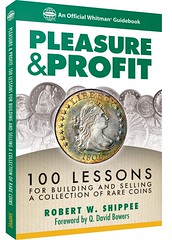 This
month we review Robert W. Shippee’s Pleasure & Profit: 100 Lessons for Building and Selling a Collection of Rare Coins, recently published
by our good friends at Whitman. Let’s start with the cover price. This full-color book, 316 pages on glossy stock, is priced at a mere $9.95, and
honestly I don’t know how the Whitman guys do it. Let’s just say it’s a good deal, and let the readers enjoy.
This
month we review Robert W. Shippee’s Pleasure & Profit: 100 Lessons for Building and Selling a Collection of Rare Coins, recently published
by our good friends at Whitman. Let’s start with the cover price. This full-color book, 316 pages on glossy stock, is priced at a mere $9.95, and
honestly I don’t know how the Whitman guys do it. Let’s just say it’s a good deal, and let the readers enjoy.
Shippee formed a collection of U.S. type coins beginning around 1995, and sold it in 2007. Shippee evaluates the purchase and sale of each coin in the collection (over a hundred), and is brutally honest about both mistakes and successes. I found it most refreshing as a collector’s view of the market. Let’s face it, most so-called “market information” comes straight from dealers, who are incentivized to create any action at all, either on the buy or sell side. Also, dealers don’t like painting a poor picture of the market, and so most of them don’t – depressing your customers is poor business. Conversely, if you are selling coins, it is always a great time for your customers to buy them.
Dealers have another problem – much of their business is confidential, or it is proprietary information that they don’t want to share with competitors. This limits their ability to be completely forthright, even they want to be. Coins are not like stocks – while auction prices are public, much of the trade remains private. Shippee is unencumbered by these limitations – he tells you what he paid, what he sold it for, and his opinion of why the coin “worked” or didn’t work.
Some examples taken from the Seated coins while give an idea of what the author is trying to do. An 1885 Proof half in PCGS PR66, held for nine years, sold for the exact same as the purchase price. Shippee explains “I was seeking extra points for my PCGS registry set…It wasn’t exactly ugly, but it had no pizzazz….Be sure you actually like the coins you buy.” An obvious lesson – don’t be a slave to the numbers on the slabs.
The 1849 dollar in MS64 was more of a success story. In this case, Shippee found an attractive coin in an auction, submitted a reasonable bid, and the coin slipped through for much less than his maximum bid. The lesson here is to look for nice coins, bid reasonably, and good success will occasionally follow. In this case, he purchased the coin for $9,200 and sold for $27,600, perhaps to a buyer thinking the coin would upgrade. The book is full of such advice, and somehow it becomes more visceral when we are talking about actual coins bought and sold. One can pontificate on the overall market direction, but you make or lose money on individual coins, and this book analyzes over a hundred such deals.
I have only one quibble with the book, and that is that Shippee sold his collection in 2007 into an extraordinarily strong market. While he freely admits this, I think the point is not emphasized enough. His total investment in the collection was about $1 million, and the 2007 sale (which netted $1.5 million), while a credit to his market timing, doesn’t reflect the recent ups and downs of the market. I doubt this book would have been written if the financial return had not been so strong.
Readers may also find Shippee’s views on golf, interwoven throughout the book, not really applicable to the matter at hand. Personally I enjoyed that part of it (each chapter starts off with a rather amusing golf joke), but being the sort of person who would buy a new television just to watch the Masters via the latest technology, I am more amenable to such things. I thought on the whole the golf angle worked, and give kudos to Whitman for being bold enough to allow just the right amount of whimsy into a numismatic volume.
For more information on the Liberty Seated Collectors Club, see:
www.lsccweb.org
MARGO RUSSELL 1919-2015
Joel Orosz writes:
Margo's place in numismatic history is certainly secure for her accomplishments in transforming Coin World from its late start-up days into a fully-realized numismatic newspaper. Nor should anyone underestimate how effectively she opened the door for the participation of women at every level of numismatics.
One remarkable fact to note: until January of 2015, it was possible to gather every person who had ever occupied the Editor's chair at Coin World, from 1960 to date, in a room together--Dick Johnson, Margo, Beth Deisher, Steve Roach--and take a group picture. 55 years! The editor's chair at Coin World must confer longevity on all those who occupy it!
 Former
Coin World Editor Margo Russell, 95, died Jan. 26 in Sidney, Ohio.
Former
Coin World Editor Margo Russell, 95, died Jan. 26 in Sidney, Ohio.
Mrs. Russell, often called the "First Lady of Numismatics," served as editor for 23 of Coin World’s first 25 years of operation, before retiring Feb. 28, 1985. She began her newspaper career in Ohio at the age of 17 at the Sidney Daily News.
In 1960, she transferred her journalism skills to Coin World, a new sister publication to the daily newspaper, and in 1962 she took over responsibility for the editorial department when she was named executive editor; later she was promoted to the editorship.
Award recognition
Mrs. Russell received many honors from her peers in the collecting community during her decades of service to the hobby.
She was presented with numerous awards from the Numismatic Literary Guild, including its highest award, the “Clemy.”
She was also a recipient of the ANA’s Medal of Merit and the association's highest honor, the Farran Zerbe Award, and was inducted into the American Numismatic Association Hall of Fame.
Mrs. Russell was given a diploma of recognition from the Sociedad Numismatica de Mexico. She also lectured about numismatics at the Massachusetts Institute of Technology, as well as Purdue and Roosevelt Universities, and state and regional numismatic educational forums.
Margo’s memories
In the April 5, 2010, issue of Coin World, focusing on numismatic events in the 1960s, Mrs. Russell submitted her observations of those early days.
“In 1960 visionary publishing entrepreneurs in Sidney, Ohio, launched Coin World, the first weekly newspaper for coins and their devotees. After 50 years, the founders’ philosophy, ‘The Collector is King,’ is as good as gold, not only for a hobby but for a science and a profession.
“Early in 1960 I was asked to develop, from home, freelance coin features for the start-up Coin World. … I was given the heady title of historical researcher. I moved to full time, then as executive editor and editor. When the board of directors named me editor in 1967, publisher [J. Oliver] Amos told me I had filled the post, sans title, for some time.
“My first American Numismatic Association convention was in Boston in 1960.
“The first issue of Coin World was timed appropriately to appear during National Coin Week in April 1960.
To read the complete article, see:
'First Lady of Numismatics' dies: Former Coin World
Editor Margo Russell, 95 (www.coinworld.com/news/former-coin-world-editor-margo-russell-dies.html)
 Margo Russell, 95, who died Wednesday in Sidney, was a community leader whose influence and expertise were
sought and honored nationally and internationally.
Margo Russell, 95, who died Wednesday in Sidney, was a community leader whose influence and expertise were
sought and honored nationally and internationally.
A reporter for the Sidney Daily News when she was 17, she enjoyed a long career in publishing at Amos Press (now Amos Media Inc.), eventually serving as editor of Coin World magazine.
The Coin World position catapulted her into national appointments by President Lyndon B. Johnson, onto committees with senators, congressmen and national leaders and into lecture halls at major universities. She garnered many awards from numismatic organizations.
Her marriage to Marion Russell, who preceded her in death in 1997, made her a member of the founding family of Dorothy Love Retirement Community, where she served on the boards of the local facility and also of Dorothy Love’s parent company, Ohio Presbyterian Retirement Services.
To read the complete article, see:
Community remembers Margo Russell
(www.sidneydailynews.com/news/news/151529134/Community-remembers-Margo-Russell)
Dave Bowers writes:
Margo was a great defining figure in American numismatics, with few equals. I have been close to her ever since 1961. She will be the subject of the “Coins and Collectors” column I will write for Coin World this weekend.
Ken Bressett writes:
I was deeply saddened to learn of the passing of Margo Russell. She was a dear friend not only to me but also to the scores of others who knew her. She was a leader in many ways, but perhaps more than anything else a guiding influence on the modes and principles of how collectors and dealers should conduct their numismatic activities. My sorrow extends beyond her family and friends but also to those who were not fortunate enough to have known her, for there will never be another quite like this Grande Dame of our hobby.
Ed Reiter writes:
Margo Russell was a towering figure not only in numismatic journalism, but also in numismatics as a whole. Her groundbreaking efforts to cultivate better relations between the coin hobby and the U.S. Mint made Washington aware that collectors were a force to be reckoned with and gave us new influence with the people who make key decisions about our coinage. Mint officials attend major coin shows routinely today – but almost never did so in the years Before Margo.
Her gregarious nature, which helped her make important friends in high government places, also won Margo a legion of friends within the hobby, myself included. Through the years, I wrote occasional articles for Coin World – but, more often, I labored for rival publications. For a short time in the early 1970s, I was editor of Numismatic News, which made us direct competitors. She was, I can attest, a formidable adversary.
For a number of years, Margo was a member of “The Girls,” an impromptu troupe that performed song-and-dance skits at annual Bashes of the Numismatic Literary Guild. The elaborately costumed ladies also included such other luminaries as ANA President Virginia Culver and Mint Directors Eva Adams and Mary Brooks. Their meticulously choreographed routines were always a highlight of each evening’s program.
Although I have been deeply involved with what passes for “entertainment” at NLG Bashes for more than 30 years, I never offered The Girls my two cents’ worth. I’ve done foolish things now and then, but tinkering with success wasn’t one of them. Margo Russell enjoyed a long, full life, less than five years short of a century. And luckily for us, she spent much of it planting the seeds for our hobby’s remarkable growth and nurturing that growth to fruition.
Dick Johnson writes:
Nobody worked closer with Margo Russell than I during the early months of Coin World. Publisher John Amos brought two writers from the newsroom across the hall of the Sidney Daily News in to help wife Shirley and I to prepare the editorial part of the paper.
[I also handled the classified ads (since I was class ad manager of the Kansas City Kansan previously and had the experience). I occasionally sold advertising. (the staff nicknamed me "Never Fail" since I always got an ad from any dealer I called). Cecil Watkins handled the subscriptions since he was circulation manager of the Sidney daily. He and John Amos processed the ads that came in.]
Margo was one of those two writers. The other was a senior writer who knew nothing of numismatics, but could fill two columns with words that didn't say anything. He only lasted two weeks. Margo, on the other hand, was an experienced news writer who grasp the essence of a story and could put it in words that made sense to anyone in the numismatic field.
 She was a godsend. Shirley and I wrote what stories we could handle in an
eight-hour day, but it was never enough because the paper expanded so quickly. As the first weekly newspaper in the field, it appealed to coin
dealers; they recognized they could get an advertisement in one week and sell the next, unlike the monthlies then in existence. We had to fill the
"news slot" to make the 25% editorial requirement of the newspaper to keep a second class mailing permit.
She was a godsend. Shirley and I wrote what stories we could handle in an
eight-hour day, but it was never enough because the paper expanded so quickly. As the first weekly newspaper in the field, it appealed to coin
dealers; they recognized they could get an advertisement in one week and sell the next, unlike the monthlies then in existence. We had to fill the
"news slot" to make the 25% editorial requirement of the newspaper to keep a second class mailing permit.
Margo wrote quickly and processed news articles in a format the composing room were familiar with. Her desk was always clear by the end of the day. Mine always had an article or two that needed further effort.
Margo was not a numismatist. She learned fast but I believe she never came up to the level that should be an editor of a coin publication. A fourth writer was hired from the Midwest -- James Johnson -- no relation. At one time someone prepared 20 questions to test a numismatist's knowledge across all numismatic fields. The three of us took the test. I missed two, Jim missed six, Margo's score was so bad she refused to tell us.
Be that as it may, Margo was a favorite and protégée of John Amos. She was also the company spy. Everything I did in the editorial office she reported to John Amos. I liked that, I didn't have to brag to the boss. Until the end.
I left Coin World in a dispute over compensation. Amos promised me a percent of the profits before he realized how profitable a weekly coin publication could be. He reneged. I resigned. He named Margo editor.
She ran Coin World to John Amo's satisfaction. She rose in the numismatic field because of that position. She was a great news writer despite the fact she was never a numismatist.
She lived to see the 55th anniversary of Coin World. She also observed as Coin World morphed from a newspaper into a magazine.
Sorry Margo, you and I worked at a time of Speed Graphic cameras, Remington typewriters, galley proofs, and newspaper page mats. Today every publication is computer generated and color paste-ups. The technical world has changed. But you and I can feel proud we pioneered in quickening the pace of news publishing in the numismatic field.
Harvey Stack writes:
To the family of Margo Russell
It is with great sadness that I learned of the passing of one of my dearest and wonderful friend, Margo
I first met Margo shortly after she took on the editorship of Coin World. We worked together on many of the projects she endorsed, and I am grateful that she always considered me a friend.
I worked with her in getting Congress to acquire the Lilly Collection for the Smithsonian in 1967, I was the representative for the professional numismatist regarding the development of the Hobby Protection Act, we stood together in the 1970's to be certain that the new grading services did things right, we helped each other with the development of the expansion of the ANA library and we opposed the promotional aspects within the trade, which was harmful to the real collector, and I worked with her on numerous projects to improve the way Numismatics should be encouraged.
She fought for the Hobby, went to Washington many times to testify on behalf of numismatics, wrote editorials encouraging people to collect and was a force to reckon with on any project she undertook.
The Hobby will miss her leadership and I will miss one of my greatest ,truest, and most valuable friend's from the decades I have been in the hobby.
God Bless her soul.
Harvey G. Stack
Founder of Stack's Bowers
SS CENTRAL AMERICA FINDER TOMMY THOMPSON FOUND
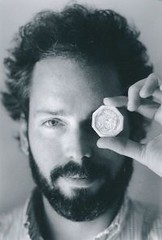 A
treasure hunter locked in a legal battle over one of the greatest undersea hauls in American history was arrested in Florida after more than two
years on the lam, authorities said Wednesday.
A
treasure hunter locked in a legal battle over one of the greatest undersea hauls in American history was arrested in Florida after more than two
years on the lam, authorities said Wednesday.
The U.S. Marshals Service tracked Tommy Thompson to a Hilton hotel in West Boca Raton and arrested him Tuesday, said Brian Babtist, a senior inspector in the agency's office in Columbus, Ohio, where a federal civil arrest warrant was issued for him in 2012 for failing to show up to a key court hearing.
Authorities didn't immediately explain how they were able to track down Thompson, whom they called "one of the most intelligent fugitives ever sought by the U.S. Marshals."
Thompson made history in 1988 when he found the sunken S.S. Central America, also known as the Ship of Gold. Much of the ship's gold was later sold to a gold marketing group in 2000 for about $50 million. The 161 investors who paid Thompson $12.7 million to find the ship never saw returns from the sale. Two of them sued. The legal battle is ongoing.
To read the complete article, see:
Fugitive treasure hunter Tommy
Thompson arrested in Florida (www.denverpost.com/nationworld/ci_27413901/fugitive-treasure-hunter-tommy-thompson-arrested-florida)
A deep-sea treasure hunter who vanished during a court fight over his $50 million haul of gold bars and coins eluded capture by hiding in a two-room hotel suite under a fake name, paying for everything in cash and keeping a low-profile, authorities said Thursday.
When Tommy Thompson and his longtime companion did leave the hotel room, usually alone and her more than him, they would use a combination of buses, taxis and walking around to shake anyone who might be tailing them.
"That's all part of the whole tradecraft — trying to fly under the radar of law enforcement," said Barry Golden of the U.S. Marshals Service in Miami.
For more than two years, U.S. marshals in Ohio and Florida worked to track down Thompson. They did meticulous research, splashed his face on electronic billboards and ran down hundreds of tips from the public. They believed Thompson was highly intelligent and had been planning to disappear for some time.
On Sept. 12, 2008, he was arrested at a Jacksonville, Florida, gas station, carrying nine identification cards — eight of which police said were fake, according to an incident report.
After his disappearance four years later, authorities found more evidence at a Vero Beach mansion he rented between 2006 and 2012, paying the monthly $3,000 rent with cash and putting the utilities in the landlord's name.
Among the clues: A book called How to Live Your Life Invisible describing how to get by on a cash-only basis; bank wraps for $10,000; metal pipes that authorities believed were used to store money underground; and 12 active cellphones, each used for specific attorneys or family members.
Based on an unspecified lead developed by Ohio agents in December, Florida authorities started focusing on Thompson's companion and longtime assistant, Alison Anteiker.
On Tuesday, agents spotted Anteiker after fanning out over an area of Palm Beach County, Golden said. They tailed her for the next seven hours, watching her use buses and taxis to get to various destinations, an obvious attempt to lose anyone, Golden said.
Eventually, Anteiker unknowingly led agents to a Hilton Hotel in suburban Boca Raton area surrounded by golf courses, country clubs and gated communities.
Thompson and Anteiker were held without bond in Florida — she on a civil contempt charge, he on a criminal contempt charge. He hasn't been charged with a crime over his handling of proceeds from the gold.
To read the complete article, see:
Tommy Thompson, Florida
treasure hunter, faces accusations over missing gold
(http://www.cbc.ca/news/world/tommy-thompson-florida-treasure-hunter-faces-accusations-over-missing-gold-1.2936403)
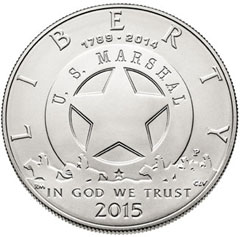
THIS FINAL JOURNEY OF THE SS CENTRAL AMERICA
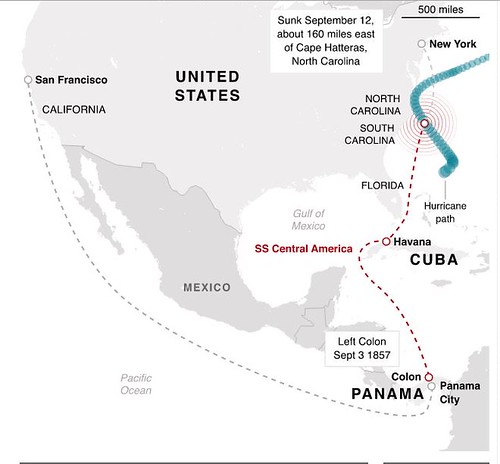
Much of the gold mined in California was transported by ship from California to Panama City, and then across the isthmus to Chagres or – once the Panama Railway was completed in 1855 – to Aspinwall, now known as Colon.
From there it was shipped to New York.
For this reason, the SS Central America was launched in 1852 by the United States Mail Steamship Company, also transporting mail, other cargo and passengers, between New York and Aspinwall.
Between 1852 and 1857 it transported one-third of the entire California Gold Rush output. Each leg of the voyage typically took between 19 and 24 days.
On September 3, 1857, the SS Central America left Aspinwall in Panama carrying 476 passengers, 102 crew members and gold.
On September 10 it encountered a hurricane off the coast of the Carolinas, and a day later sprung a leak.
By 8pm on September 12 it had sunk, about 160 miles east of Cape Hatteras, North Carolina, drowning a total of 426 passengers and crew.
To read the complete article, see:
What
was the SS Central America - or 'Ship of Gold' - and why did it sink?
(www.telegraph.co.uk/news/worldnews/northamerica/usa/11376701/What-was-the-SS-Central-America-or-Ship-of-Gold-and-why-did-it-sink.html)

THE HISTORY OF FOOD STAMP CHANGE TOKENS
For those who were not collecting in the 1970's and don't remember these tokens, a little background. From the 1930's onward, food coupons were available to individuals and families whose income was below a certain level. The system is still around today, but the coupons have been replaced by a SNAP card similar to a credit card. The coupons used during the 1960's through 1990's were the same size as and similar to currency and were probably printed at the Bureau of Engraving and Printing (they were shredded along with currency and sold in bags to visitors to the Bureau). The coupons were colorful and well-made and attracted the interest of collectors. However, possession (or collecting) of food stamps by those not registered in the program was illegal.
In the 1960's the lowest value "food stamp" was 50 cents. About 1970 that value was eliminated and one dollar was the lowest value coupon. By law stores were not allowed to give real money in change for food coupons, but the government provided no means to solve this problem. As a result, each store came up with its own method. Many stores, especially smaller stores, simply wrote out the amount of change due on the register receipt, initialed it and gave it to the customer to be used on his next visit. Other stores had paper scrip printed with which to make change. Some stores had metal tokens made to use for change. Some stores had plastic tokens made. The earlier plastic tokens came in sets of four values -- 1, 5, 10, and 25 cents. The only tokens I have seen in this series were dollar size.
When the 50 cent coupon was discontinued, stores began using 5 piece sets which included a 50 cent token. The vast majority of these five piece sets are in a standard format -- 29mm with a common reverse reading: FOOD STAMP CREDIT / (value) / IN ELIGIBLE FOODS. The colors were also standard 1c black, 5c green, 10c blue, 25c orange, 50c pink. All of these were made by the Plasco Company in LaCrosse, Wisconsin. The style of the reverse changed from time to time, all with white lettering, except on the last issue which has no colored lettering but has raised lettering instead.
The law was changed beginning in January 1979 allowing the stores to give our actual coins for amounts below one dollar, and the food stamp change tokens disappeared. The company is still in business today, still making 29mm plastic tokens for bars, but now offers other sizes and styles of tokens. There is a catalog of food stamp tokens used in California, and such tokens are listed in the supplements to the catalog of Wisconsin tokens, and possibly in the Pennsylvania token catalog. I have recorded food stamp tokens in my catalog of Missouri tokens (not yet published). In my collection I have over 50 different sets from St. Louis alone and probably 100 to 200 sets from other towns in the state. The tokens were used in all 50 states and in Puerto Rico and the Virgin Islands.
Though there has been little collector interest in them, most food stamp tokens are actually RARE. Why? When the tokens were discontinued, Neil Shafer in Milwaukee went to the manufacturer in LaCrosse and purchased all the samples kept by the company for reference. All uncirculated and mostly in full sets, thousands of these sets were sold around 1980 through auctions by Christensen & Stone (Temple City, CA) and later by other token dealers. I tried to buy every Missouri set in the C & S sales, but I missed a few --- and never saw them offered again until the past year or so.
Back in the 1980's these tokens were generally only sold in full sets and sold for $2 to $3 a set. The ones I missed which have turned up on eBay in the past year I was unable to buy at $15 to $20 a set. The reason most of these tokens are rare is because most of them only exist as samples from the manufacturer -- who was unlikely to have kept more than two or three sets from each issuer. The stores most likely threw away the ones they had on hand. Many store owners believed, incorrectly, that the tokens were also illegal to own (or collect) if you were not registered in the program.
I was living in Stevens Point, Wisconsin in the late 1970's. Three IGA food stores there used these 29mm sets. Two of the stores would sell me all the tokens I wanted -- once I pointed out that I would be selling theollecting and cataloging m to collectors and every token sold (except the one cent) would be complete profit for the store (the tokens cost the store about 3 cents each at that time). I of course paid face value for the tokens. One store refused to sell me any tokens because the manager believed it was illegal. The other two stores were particularly happy to sell me tokens from other stores in the area which they had accepted my mistake. In the end, I put together a collection of about 60 different tokens from the three Stevens Point stores, which had used seven different series of tokens (though the store was undoubtedly unaware of this).
I've been interested in this vast collecting field since 1966 when Milwaukee went on the Food Stamp Program. I believe I was the first one to cross the bridge between collectors and individuals on the Food Stamp Program- they could not save their food stamp change and collectors by and large were not involved with the Program so they had no knowledge of what was being issued to food stamp customers.
Another strong attraction to me was that such issues existed only because the government said they had to be used instead of coins; these were not what any stores wanted to use. It did not matter what form this mandated store change took, as long as it served the purpose of keeping such change within the limits of the Program
I wrote several articles in the Whitman Numismatic Journal (two in 1966, one in 1968) barely scratching the surface of this area. When USDA said no more special food stamp change was necessary as of the end of 1970, I scrambled big time and located a good number of then-obsolete issues from all over the country. They came in all forms- scrip in denominations, various one-time-usage forms, and many different kinds of tokens. Some were plastic, others aluminum, brass, cardboard, wood (size of regular wooden nickels, issued as change),
Then in March of 1972, USDA surprised everyone with the announcement that the food stamp change requirement was to be reinstated, and the scramble was on in earnest. That's when Personalized Plastics came to the fore. That La Crosse- based company put out what must have been thousands of flyers promoting their plastic token sets, as their response was tremendous. They were also sympathetic to my request for some examples, as they sent me pieces from so many different locations I had to send some to Christensen and Stone in California so they could sell them and help me to pay PP for such a quantity. I did save a set from each store.
Their shipment to me covered the approximate years from 1973 through around 1975. The company was then sold to Plasco and I was refused any more cooperation whatsoever, so I have no firsthand knowledge of anything they produced after they took over. I imagine it was in the thousands of sets to various stores around the country.
There has been some literature on the subject from time to time. Jerry Schimmel put out his Food Stamp Change newsletter for a while. In 1980 he published a listing of food stamp tokens only (no paper scrip or forms) at the time he began his newsletter. I know various state listings have also been published but i don't have more exact information (I think FL is one).
In the Dec. 1972 TAMS Journal I wrote an article titled "Food Stamp Tokens, Scrip and Due Bills Nationwide" in which I illustrated a number of different tokens (including one of the wood issues) and paper issues. In the April 1989 Numismatist, an individual named Harold F. Nelson wrote an article titled "A Collector's Feast of Food Stamps". He shows some tokens and paper change as well. I have also written various article in Bank Note Reporter on the subject from time to time.
I firmly believe this area of collecting is virtually limitless; it can never be complete, that is obvious, and any listing of any sort is always subject to revision and additions. That being said, it still does not limit the fun of collecting something that has strong social connotations, plus the very possible discovery of previously unknown issues to the numismatic world).
To read the earlier E-Sylum article, see:
FOOD STAMP CHANGE TOKEN INFORMATION SOUGHT (www.coinbooks.org/esylum_v18n04a06.html)
NOTES FROM E-SYLUM READERS: FEBRUARY 1, 2015
Stubenrauch Tokens & Medals
Bruce Smith writes:
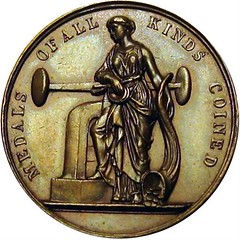 Stubenrauch had a long career making medals and tokens in St. Louis since before the
Civil War. For a few years during the war (1863-64?) he was in partnership under the name Stubenrauch & Weber. Some of the St. Louis Post Office
tokens bear this name in small letters at the bottom, which makes them Civil War era tokens. Some of the Post Office tokens probably pre-date the
Civil War, and others are clearly from after the war. All of these pieces, which have hand engraved names on the reverse, are unique and are probably
actually identification pieces for people picking up mail for the various firms named on the tokens. Sometime in the 1870's Stubenrauch moved to
Texas where he continued in the engraving business.
Stubenrauch had a long career making medals and tokens in St. Louis since before the
Civil War. For a few years during the war (1863-64?) he was in partnership under the name Stubenrauch & Weber. Some of the St. Louis Post Office
tokens bear this name in small letters at the bottom, which makes them Civil War era tokens. Some of the Post Office tokens probably pre-date the
Civil War, and others are clearly from after the war. All of these pieces, which have hand engraved names on the reverse, are unique and are probably
actually identification pieces for people picking up mail for the various firms named on the tokens. Sometime in the 1870's Stubenrauch moved to
Texas where he continued in the engraving business.
To read the earlier E-Sylum article, see:
SELECTIONS FROM THE HAYDEN JANUARY 25 2015 SALE : Charles Stubenrauch Medals Of All Kinds
Coined (www.coinbooks.org/esylum_v18n04a19.html)
More on Encased Coins
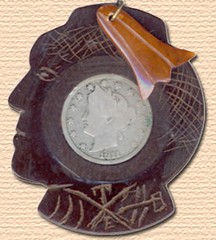
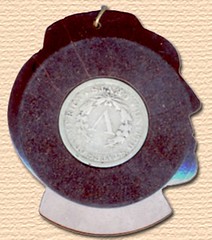
Regarding the bakelite encasement Frank Van Valen wrote about, Bob Leonard writes:
I've never seen this item before, but it looks like some kind of summer camp project. Also, I don't see how Frank can date it to 1911, since the nickel is worn to only G-VG condition; I'd date it closer to 1940 or even 1950, and suspect that the holder was intended for a BUFFALO nickel, but someone decided to substitute one of the old Liberty Head nickels instead.
I have seen a lot of encased coins over the past 40 years. Normally the encasement is aluminum or less commonly brass. I have also seen modern plastic encasements. The coins are usually pennies, though I have seen nickels and quarters, and I have seen Canadian large and small cents encased. I also once had a small Swiss coin encased -- issued for the centennial of a Swiss community here in the USA.
The encasements are normally round or horseshoe shaped, but other shapes are known -- the rarest of which is in the shape of a teddy bear. I have sold a few 1948 encased cents, issued for the centennial of Wisconsin statehood, in which the encasement was in the shape of the state. But I have never seen or heard of a bakelite encasement nor of an encased V nickel. No doubt you will hear from Alan Weinberg, who is the king of encased coin collectors.
Alan V. Weinberg writes:
To quote the late great John J. Ford, Jr: "cockamamie".
To read the earlier E-Sylum article, see:
BAKELITE "MOHAWK" ENCASED LIBERTY NICKEL
(www.coinbooks.org/esylum_v18n04a14.html)
Information on Phares O. Sigler Sought
Bruce W. Smith writes:
I wonder if any E-Sylum readers can provide any background information on Phares O. Sigler (1899-1974), best known for his 1951 Numismatic Bibliography and his many articles on primitive money in The Numismatist and Numismatic Scrapbook. He is less well known as the author of the first book (in any language) on Chinese sycee silver ingots (1943). He was a Colonel in the J.A.G.C. (Judge Advocate General Corps) and lived in Silver Spring, Maryland. I found an article he wrote on Japanese netsuke in 1974, so he must have had interests beyond numismatics.
Notes and Coins Will Be Overtaken By Cashless Payments
Banknotes and coins will be less popular than digital money by early March as cashless payments overtake cash transactions for the first time, analysis by The Times suggests.
The surging popularity of contactless credit cards and fast online bank transfers has reduced our reliance on physical currency, official figures show.
The Payments Council, which oversees all payment services in Britain, predicts that 400 million fewer cash transactions will be made this year than last.
David adds:
Perhaps as cash goes there will be more use for tokens. People do not like using card payments for car parking for example.
To read the complete article, see:
Notes and coins will be overtaken by cashless payments within
weeks (www.thetimes.co.uk/tto/money/consumeraffairs/article4339115.ece)
Image of the Macerated Currency bust of George Washington
Regarding the Macerated Currency bust of George Washington, Paul Bosco writes:
Steve Tanenbaum asked me to appraise the damaged George Washington macerated currency bust, to put a dollar value on said damage. Steve Hayden's recollections match mine. What no one has mentioned thus far is that the piece was made for the 1932 birth centennial, rather later than the norm for macerated currency souvenirs.
As for Tanenbaum's skills as a package maker... I would occasionally let Steve T use my mailing table. Not a good idea. Once, having slathered a box with multiple pounds' worth of wet paper tape, he put it down on the table, on top of some 2x2 paper envelopes, containing thin jettons. These stuck to the bottom of the box and he unknowingly carried them off. Some were recovered. When my lease ends and I dis-assemble the table, I may recover more.
There may be as many Tanenbaum stories as Walter Breen stories.
Steve Hayden writes:
I found the picture. It is on page 31 of Dave Bowers's book A Guide Book of Washington And State Quarters.
![Washington, George-Houdon bust pic [SLT and Steve Hayden]](https://farm9.staticflickr.com/8561/16409066051_a9ba9c7ff5_m.jpg)
![1932-Houdon bust in papier mache [SLT and Steve Hayden]-1](https://farm8.staticflickr.com/7357/16409066181_b40bbc1d2b_m.jpg)
To read the earlier E-Sylum article, see:
NOTES FROM E-SYLUM READERS: JANUARY 25, 2015 : More on the Macerated Currency Bust of George
Washington (www.coinbooks.org/esylum_v18n04a09.html)
Crowd-Sourcing a Medallic Visual Dictionary
Regarding Dick Johnson's call for a medallic visual dictionary, Chip Howell writes:
This seems like the perfect project for crowd-sourcing input: place the image(s) on-line, and let people tag them the way they do other pictures. The cataloger (curator-webmaster, really) could incorporate most or all of the suggestions into a series of hierarchical look-ups which could borrow liberally from heraldry (e.g. animal => dog => greyhound => "passant" => "sinister" => "regardant"), to facilitate searching.
I can't imagine, given the scope of the subject, that this would work anywhere EXCEPT on-line: has anyone got a rough idea how many medals there are? Yeah, I didn't think so... Anyway, putting "greyhound" & other terms (the particular metal, orientation, shape, and/or size) into the site's search engine would grab all images so-tagged: then you'd have a visual dictionary of sorts.
To read the earlier E-Sylum article, see:
WANTED: A MEDALLIC VISUAL DICTIONARY (www.coinbooks.org/esylum_v18n04a11.html)
The Euro and Monetary Unions in History
Regarding the Euro and Monetary unions in history, Georges Depeyrot writes:
The victory of Syriza in Greece is a major event for the history of Euro. Will it be a rebirth of the monetary union of the beginning of the end?
We are now working on a European application on monetary unions in history. You can find a website on a previous program on http://www.emu-cost.net/, documents and videos on our actual program (on the collapse of the 19th monetary union) on DAMIN ( www.anr-damin.net) and the publications of Moneta ( www.moneta.be).
Georges adds:
We will have a meeting in May in Copenhagen (28-29 May) on the question of the technology of minting, mainly 19th century but some papers concern other periods. It will take place at the Royal Museum. Attendance is free. Abstracts on www.anr-damin.net
Query: First Use of Term 'Permanently Impounded' Sought
Paul Bosco writes:
Can a coin be criminal? We read, especially in auction descriptions, the cliché "permanently impounded". What is the history of this banal usage in numismatics?
I would speculate (totally gratuitously) that it was sour grapes from B. Max Mehl, annoyed at losing a consignment to a charitable donation. Or maybe Tom Elder, annoyed at spilling a drink.
To read the earlier E-Sylum articles, see:
INDIAN PEACE MEDALS IN STACK'S BOWERS 2015 AMERICANA SALE
(www.coinbooks.org/esylum_v18n04a13.html)
CONTEMPORARY COUNTERFEIT COINS (www.coinbooks.org/esylum_v18n04a15.html)
Correction: 100 Times Estimate
Last week I wrote:
The 1796 cent sold on Wednesday 21st by Salisbury, Wiltshire (United Kingdom) auctioneers Woolley & Wallis. It was estimated at £500-700 The coin hammered for £48,000, over ten times estimate.
Rich Hartzog writes:
Well, no, try 96 times low estimate.
To read the earlier E-Sylum article, see:
NOTES FROM E-SYLUM READERS: JANUARY 25, 2015 : 1796 Cent S-96 Sold in Woolley & Wallis
Sale (www.coinbooks.org/esylum_v18n04a09.html)
Warning: SHOPPERZ Malware
Bruce Smith writes:
While searching in Google, I came across an article titled "Money in Ancient China" and clicked on it. Big mistake. There was no article, but it downloaded a site or program called SHOPPERZ which plastered the screen with pop-up ads. As fast as you click them to go away, another would appear. These pop-ups appeared mostly when I was on eBay, but when I was at other sites, they didn't show up at all. I ran Kaspersky twice, but it didn't solve the problem. Finally had to call the Geek Squad at Best Buy (definitely worth the $100 a year for the personal service). They managed to fix the problem, but it took "Steven B2" seven hours (poor guy). I was sitting at the screen too, expecting it would take up to an hour to fix (poor me). Anyway, all is well now.
HELP SOUGHT FOR WHITMAN OBSOLETE PAPER MONEY PROJECT
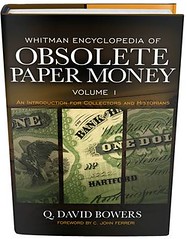 Whitman Publishing announces a call-to-action for all collectors of obsolete
paper money to pitch in and help build the best historical and market reference ever compiled in this field. Collectors, researchers, dealers,
historians, and others in the hobby community are encouraged to get involved with this important project. Images, historical research, market
analysis, and general insight are welcome for the Southern states, the Mid-Atlantic states, the Midwest, and territories.
Whitman Publishing announces a call-to-action for all collectors of obsolete
paper money to pitch in and help build the best historical and market reference ever compiled in this field. Collectors, researchers, dealers,
historians, and others in the hobby community are encouraged to get involved with this important project. Images, historical research, market
analysis, and general insight are welcome for the Southern states, the Mid-Atlantic states, the Midwest, and territories.
In particular, “state editors” for the upcoming states of Alabama, Arkansas, Kentucky, Louisiana, Mississippi, Tennessee, and Texas are sought. Each state editor will work closely with author Dave Bowers, Whitman publisher Dennis Tucker, and Whitman senior associate editor Caitlyn Mitchell to track down facts, look into questions, scrutinize the historical record, gather and examine images, and otherwise act as that state’s expert. Editors have a chance to take a “co-starring role,” as C. John Ferreri has done with the states in New England, and join contributors the likes of the American Bank Note Co., the American Numismatic Society, and the Smithsonian Institution, all of whom (among other museums and private collectors) have shared images. Collectors active in the market of buying, selling, or trading, can volunteer to analyze valuations. Historians with knowledge of a particular state or region can review state, town, and bank histories—fascinating narratives soaked in Americana!
Received with warm welcome at its debut at the Memphis International Paper Money Show in 2014, the Whitman Encyclopedia of Obsolete Paper Money is continuing on strong with four volumes published to date. Within each volume is author Q. David Bowers’ knowledge on obsolete paper money—its history, how to collect it, and observations on the general market, including rarities, supply and demand, and pricing. Volume 1 is an introduction for collectors and historians. Volume 2 studies in detail the states of Connecticut, Maine, and New Hampshire. The two-part Massachusetts volumes, numbering 3 and 4, were released this past winter, and the last volume in the New England region is scheduled to arrive this spring, comprising of Rhode Island and Vermont. Now moving south and west, the monumental study on obsolete currency continues to unfold. The entire series will encompass 14 volumes of 400 to 800 pages each.
Obsolete notes are paper currency issued from 1782 to 1866, before the modern era of National Banks and the Federal Reserve. Over the course of these decades more than 3,000 state-chartered banks released their own paper money for day-to-day commerce, in thousands of colorful and ornate varieties. In the Whitman Encyclopedia of Obsolete Paper Money, each note listed is studied in detail, and thousands are pictured in full color, with information on grading, rarity, values in multiple grades, significant auction results, advice for collectors, and other valuable guidance.
Anyone interested in volunteering can contact Whitman Publishing at obsoletes@whitman.com. Volunteers will be credited in the books’ acknowledgments.
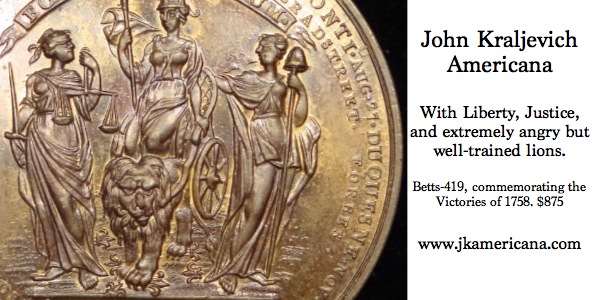
PCGS UNVEILS DIGITAL COIN ALBUM
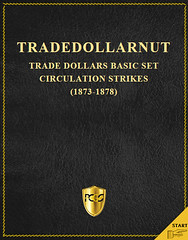

Now you can see and even show your PCGS Set Registry® coins handsomely displayed in a customized album anytime, 24 hours a day, even if your prized coins are stored in a far-away bank vault or elsewhere.
Professional Coin Grading Service (www.PCGS.com) has created the PCGS Digital Coin Album, a way for collectors to display and share their coin sets online in a beautiful format resembling a traditional coin album. The new feature is free and easy to use.
"The PCGS Set Registry would not be possible without internet technology, and now we’ve used technology to take what we feel is the next giant step for PCGS Set Registry efficiency, fun, and enjoyment," said BJ Searls, PCGS Set Registry and Special Projects Director.
"We’ve developed a way for you to create an elegant coin album which you can enjoy yourself or share with your friends anytime. You simply login to My Set Registry, visit one of your sets, and build the album with the images you have added to your set," explained Searls.
You can choose from one of six different color palettes for each album and you can add your own set description to the cover. Once you "publish" your album online, it is linked from your set in the Registry and can be downloaded and printed as a PDF file. You can admire it anytime, anywhere online, and you can share it with other collectors on the PCGS Set Registry website and through other social media.
"This new digital approach combines the way we all used to collect with albums to house and display our coins with the technology of today. This dramatically changes the way you can enjoy and display your sets. In fact, your kids might even like it!," said Searls.
For more information, see:
www.PCGS.com
UPDATE: NUMISMATIST ISSUES STILL SOUGHT
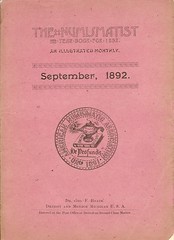 1896
(missing Oct, Nov issues)
1896
(missing Oct, Nov issues)
1901 (missing May issue)
1902
1906 (missing Feb issue)
1917
1919
1920
1921
1923
1926
E-Sylum readers who can help are invited to contact Editor Barbara Gregory, 818 N. Cascade Ave., Colorado Springs, CO 80903-3279, phone 719-482-9831, e-mail gregory@money.org .
To read the earlier E-Sylum article, see:
NUMISMATIST ISSUES SOUGHT FOR DIGITIZATION (www.coinbooks.org/esylum_v18n04a05.html)
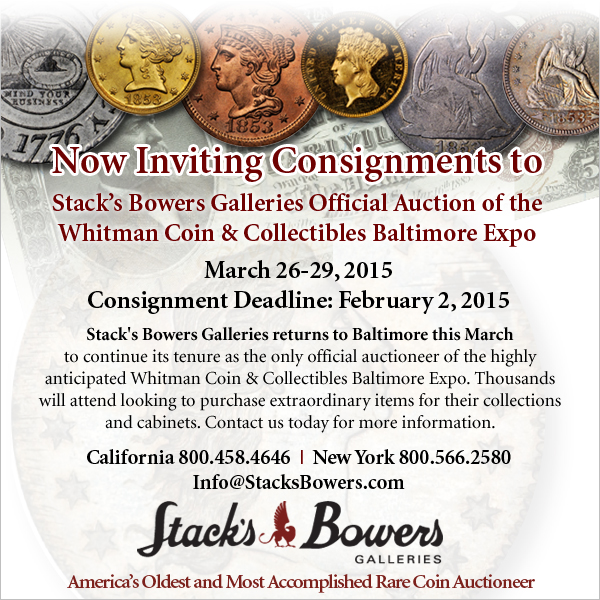
MORE ON 19TH-CENTURY NUMISMATIST WARREN GEE
Warren Wallace Gee (1830-1905) was born at Portage County, Ohio on August 6, 1830, son of Nicholas and Adaline Daniels Gee. His mother was a direct descendant of Amariah Daniels (1769-1841) who served as a musician during the American Revolution. His father was a native of New York and his mother of Massachusetts.
Gee's Early Life and Commercial Career
On April 2, 1850, at Logan, Ohio, he married Margaret “Maggie” Kildahl a Norwegian immigrant. They had two daughters Ava and Gertrude. Gertrude later on married George D. Sisson. The Gee family lived in Ohio when Ava was born. However, they moved to Hartford, Wisconsin, and then soon settled in Spring Lake, Ottawa County, Michigan. By 1870 he was a well established and highly prosperous produce merchant. In 1874 he was listed as a capitalist in the Milwaukee Grain & Stock Exchange. By 1880 he became a very wealthy wheat broker. In 1882 he was elected as the president of the Spring Lake Horticultural Society.
Gee's Numismatic Career
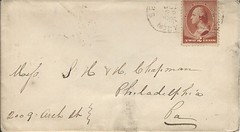 In the mid 1880’s he became a somewhat part-time coin dealer. Most of his coins appear to have
been acquired over the counters on his business trade, keeping the best and creating a set of American coppers and some foreign currency and selling
off other specimens at a premium. He was a correspondent to the Chapman Brothers beginning in 1885. Drawn by coin dealings he visited Philadelphia
January 20, 1885 and January 11, 1886, where he stayed at the American Hotel. He was a subscriber to A. M. Smith, Illustrated Encyclopedia of Gold
and Silver Coins of the World; Illustrating the Modern, Ancient, Current and Curious, From A.D. 1885 Back to B.C. 700. (Philadelphia, 1886) : as he
is listed among the subscribers on page 12.
In the mid 1880’s he became a somewhat part-time coin dealer. Most of his coins appear to have
been acquired over the counters on his business trade, keeping the best and creating a set of American coppers and some foreign currency and selling
off other specimens at a premium. He was a correspondent to the Chapman Brothers beginning in 1885. Drawn by coin dealings he visited Philadelphia
January 20, 1885 and January 11, 1886, where he stayed at the American Hotel. He was a subscriber to A. M. Smith, Illustrated Encyclopedia of Gold
and Silver Coins of the World; Illustrating the Modern, Ancient, Current and Curious, From A.D. 1885 Back to B.C. 700. (Philadelphia, 1886) : as he
is listed among the subscribers on page 12.
He was also a subscriber to Mason’s Coin Collectors’ Magazine in 1890 listed among the subscribers in the September issue.
Gee's Later Life and Commercial Career
In April 1888 he was at the Board of Trade Milwaukee, Wisconsin. He stayed at the Palmer Hotel, Chicago on July 9, 1889. Sometime between 1891 and 1902 he had an office at 56 Board of Trade, Chicago, Illinois.
From 1890-1891 he partnered with Dr. Cyril P. Brown who patented a mechanical device the “Musical Leaf Turner” that turned the pages of sheet music so that a musician could play continuously without interruption.
In May 1893 his Spring Lake house burnt down among the more than thirty that were destroyed by the great Spring Lake fire. The fire started on May 11, at Haire’s dock at 8 a.m. was spread by a strong wind. It seems tenable that the numismatic collection was lost and destroyed in that fire.
In 1896 he formed a partnership in a grain company with George Knowles in a firm Gee & Knowles located at 357 Broadway, Milwaukee, Wisconsin. In 1897 he built a home there.
He died on October 16, 1905. After his death his wife moved to Indianapolis Indiana.
I also heard from Kay Olson Freeman, our resident genealogist, who unearthed a few more pieces of the puzzle. Thanks! - this is a lot of work. -Editor
Kay writes:
I have corrections to John Lupia’s biography of Warren W. Gee:
I am not sure the middle initial “W” stands for “Wallace.”
Warren W. Gee married two times with a daughter by each marriage:
1) married Adelia M. Gee in Logan, Ohio, on April 2, 1850. She was born 1834, OH. She dies between 1861 and 1867.
They have a daughter, Evaline Adelia Gee, born 1861, OH. She is called “Eva” NOT “Ava.” Evaline marries Henry Harrison Hungerford.
2) married Margaret Kildahl Rice in Milwaukee, on Nov. 6, 1867. Kildahl was maiden name and she had been married, 1854, to John Rice, born 1827, Ireland.
Did John Rice die – maybe Civil War? Margaret and John Rice seem to have daughter, Minnie Rice, born 1856, Wisconsin.
Warren and Margaret’s daughter was Gertrude Margaret Gee, born, 1876, MI. Gertrude marries George Dwight Sisson, Jr.
The possible loss of the coin collection in the house fire should have been reported in newspapers at the time.
Someone could look at Warren Gee’s will which is probably in Wisconsin or Michigan, not Indianapolis. Warren moved to Indianapolis – Lupia stated only his wife moved there.
Google Gee’s business partner “George Knowles, Jr.” Milwaukee is trying to preserve Knowles’ house. Site mentions Gee, but Gee is bit of mystery to preservationists there too.
Descendants of Warren W. Gee (b. 1830, Ohio – d. 1905, age 75, Spring Lake, Mi) Warren’s 2nd wife, Margaret Kildahl Gee, dies in Indianapolis, Indiana, April 1932, age 96 (born Norway 1836)
Margaret K. Gee buried April 27, 1932 in Crown Hill Cemetery, Indianapolis. She is not buried with husband Warren in Spring Lake, MI. Margaret K. Gee is buried with her daughter and son-in-law.
I assume Warren and Margaret Gee moved to Indianapolis @ 1903 from Milwaukee to live near their daughter: Gertrude Margaret Gee, born June 1876. Their Indianapolis address was the same as their daughter and her husband.
Gertrude M. Gee married 1900 in Milwaukee, George Dwight Sisson, Jr. The Sisson family had lived in Spring Lake, Mi as well and had a large lumber business. The Sissons had relocated their lumber business to Indianapolis
Gertrude M. Gee Sisson dies in Indianapolis March 1906. Her husband, George D. Sisson, Jr., does not remarry and dies Sept. 1930, Indianapolis. Gertrude and George D. Sisson had one son, also named George D. Sisson, Jr (born 1901, Indianapolis – died June 1970, Indianapolis). The latter had a wife, Patricia M. (b. 1908 – died 1994, Ft. Meyers, FL).
Warren W. Gee had a daughter by 1st marriage: Evaline (Eva) Adelia Gee born 1861, Ohio. Evaline marries 1882, Spring Lake, MI, Henry Harrison Hungerford. By 1900, They are residing in Chicago where Henry H. Hungerford is an inventor. He had patents for packaging things like crackers.
Evaline Gee Hungerford died Aug. 1936, age 75, in Saugatuck, MI. Henry H. Hungerford (b. 1854 - died 1945, Chicago). Evaline and Henry had a son: Warren Harrison Hungerford (1887- 1962). Warren H. Hungerford had 2 sons: Henry H. (1913-1976) and George B. (1916-1980), both married and had children.
This descent assumes that possessions pass from husband to wife to children which may not have happened to Warren W. Gee’s coin collection.
Because of the death dates, the coin collection may have been inherited by sons-in-law – Sisson (Indianapolis) and Hungerford (Chicago).
Warren Gee’s will (if he had one) would have to be consulted to see if coin collection is mentioned – unless collection had been disbursed earlier, before 1905.
I wonder if Warren W. Gee became interested in American history because his mother, Adeline Daniels Gee (1812- 1880) was born in Massachusetts and traced her ancestry to Revolutionary War military. Warren’s father, Nicholas Gee (1802-1879) was born in NY State. [most of the Gees I have encountered are from NY State]
Another odd thing, I have not been able to determine what Warren Gee’s middle initial “W” stands for. He seems to have had a younger brother, Wallace Gee, born 1845/1847?, Ohio. Some records say the brother’s name is Warren Wallace Gee and he moved to Alabama, married, had children, and died there 1916.
Another person mentioned in newspaper article is Warren W. Gee’s last Milwaukee stockbroker partner: George Knowles, Jr. (b.1853-d. 1916). Knowles moved into Gee’s Milwaukee house when Gee removed to Indianapolis.
Joel Orosz asked, "Was Warren Gee related to E. Gordon Gee, controversial President of many colleges?" Kay writes:
I would say no relation. Elwood Gordon Gee was born 1944 in Utah into a Mormon family which resided in Utah for several generations. Also, it is just a coincidence that E. Gordon Gee was succeeded by an interim President (1997-1998) of Ohio State University by John R. (Richard) Sisson, born 1936.
The fate of Gee's collection is still a mystery, but now we have more clues, including the ominous fire. How about opening a related topic - what numismatic collections do we know of that were destroyed by fire, flooding or some other natural disaster? -Editor
John Lupia writes:
This is spectacular. Thank Kay for me. Kudos to you all. Great work!
Joel Orosz writes:
John Lupia's Numismatic Mall has certainly become a valuable resource--I'll remember to look there first next time a question arises.
Kay Freeman is an amazing researcher--more than once, I have thrown up my hands in despair on some abstruse point, only to have Kay track it down and present it to me on a silver platter. If she finds it, you can take its veracity to the bank!
To read the complete Encyclopedia article, see:
GEE, WARREN
WALLACE (https://sites.google.com/site/numismaticmallcom/encyclopedic-dictionary-of-numismatic-biographies/gee-warren-wallace)
To access Lupia's Encyclopedia, see:
Encyclopedic Dictionary of Numismatic
Biographies? (https://sites.google.com/site/numismaticmallcom/encyclopedic-dictionary-of-numismatic-biographies)
To read the earlier E-Sylum article, see:
19TH-CENTURY NUMISMATIST WARREN GEE (www.coinbooks.org/esylum_v18n04a10.html)
MORE ON H.E. STONE AND PHILA-NUMIS

H.E (Harry Everette) Stone was my maternal grandfather. The Phila-Numis logo was probably my grandfather’s most authentic identity in spite of the fact that he was known as Dean Stone to all in Morgantown and throughout W.Va. after decades serving WVU in that capacity.
Finally, I have been able to retrieve this entry in Who’s Who in America. We had the book in our den when I was in high school. This is the most accurate bio of H.E. Stone, written by him for the Who's Who entry in about 1956, several years before his death. He was a brilliant multilingual gregarious man and a great storyteller! As you can see, his memberships in your associated societies were of utmost importance to him:
FIRST NAME:
Harry Everette
LAST NAME:
Stone
OCCUPATION:
educator.
BORN:
Corry, Pennsylvania, Dec. 31, 1883.
DETAILS:
Son of Nathaniel and Emma (Goodell) S.; A.B., Allegheny Coll., 1905; student law dept. U. of Mich., 1907-08; spl. courses in edn., U. of Pittsburgh; A.M., Teachers Coll. (Columbia), 1922; grad. and research work Columbia, summers 1936-40; married Sarah Day, 1907 (dec.); children—Ward Day. Eleanor Jane (Mrs. William A. Thornhill, Jr.). Began as teacher in high school, Cambridge Springs, Pa., 1905; teacher high sch., Meadville, 1909-14; dir. Americanization, and vocational counselor, pub. schs. of Erie, Pa., 1915-22; dean of men. W.Va. U., 1922-36, head guidance, placement, loan service, 1936-50, was appointed research associate in placement, 1950, ret.; now dir. Phila Numis-Research in Ancient Archaelogy (coins, medallions, etc.), founder, 1951. Fellow Royal Soc. Numismatic Soc. Great Britain; mem. Am. Numismatic Soc. (research 1958), National Assn. Deans and Advisers of Men (vice pres. Eastern U.S. Div., 1929-30; mem. exec. bd., 1930-31), N.E.A., Nat. Soc. for Vocational Edn., Pa. State Edn. Assn. (pres. Americanization div., 1921-22), W.Va. State Edn. Assn., Personnel Research Fedn., American College Personnel Assn. (v.p., 1937-38), Association of School and College Placement, Am. Numis. Assn. XX Club (ex-pres.), Phi Gamma Delta. Republican. Presbyterian. Mason (32°, Shriner); K. T. Rotarian. Lectr.; contbr. to mags. and periodicals; author leaflets on careers, on numismatics as source book for educators. Home: 123 Park St., Morgantown, W.Va
My mother was Eleanor Jane Stone (Thornhill). Ironically, my “Grandpa Stone” died on January 31, 1959 (56 years ago today), which also happened to the birthday of my father (William A. Thornhill, Jr.). So, January 31 is one of those family dates that has double sentiment. We grew up steeped in stamps and coins. It was a lifelong passion of my Grandfather and my uncle and mother. I have two Stone cousins still living in Morgantown, one a retired judge (The Honorable Robert B. Stone) and the other a practicing attorney (Ward D. Stone, Jr.). Both my grandparents (H.E. Stone and S.D. Stone) are buried in Morgantown.
The Phila-Numis logo was probably my grandfather’s most authentic identify in spite of the fact that he was known as Dean Stone to all in W.Va. after decades serving WVU in that capacity.
This is the most accurate bio of H.E.Stone, written by him for the Who's Who entry in about 1956, several years before his death. He was a brilliant multilingual gregarious man and a great storyteller! As you can see, his memberships in your associated societies were of utmost importance to him.
Thank you for your dedication to this fascinating work. I hope to contact you again soon regarding how I might proceed to have the rare coins and large volume of stamps (!) left by my Grandfather appraised in the Phoenix Metro Area. As the eldest, the most interested, the most retired, I have become the depository!
To read the earlier E-Sylum articles, see:
QUERIES: NUMISMATIC COMMUNICATIONS, H. E. STONE
(www.coinbooks.org/esylum_v14n53a18.html)
MORE ON H.E. STONE AND S.D. STONE (www.coinbooks.org/esylum_v15n01a14.html)
A.M. SMITH'S ILLUSTRATED HISTORY OF THE U.S. MINT
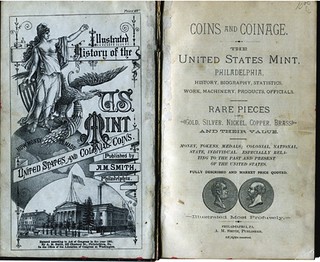 Philadelphia publisher and collector Andrew Madsen Smith produced a 107-page pocketbook-size
volume that covered the breadth of American coins in remarkable depth some 65 years before coin collecting got its bible, R.S. Yeoman’s A Guide Book
of United States Coins (the Red Book) in 1946.
Philadelphia publisher and collector Andrew Madsen Smith produced a 107-page pocketbook-size
volume that covered the breadth of American coins in remarkable depth some 65 years before coin collecting got its bible, R.S. Yeoman’s A Guide Book
of United States Coins (the Red Book) in 1946.
The Illustrated History of the U.S. Mint was produced for the better part of two decades, first by Smith and later by George Evans. As the years went by, the book grew to nearly 200 pages and included 24 pages of photographic plates.
Each edition is a treasure, but the first, printed in 1881, speaks especially to its day.
The title page contains a line drawing of William Barber’s wordlessly eloquent Lincoln and Garfield medal. The quarter-size medal has no legend but shows the busts of Abraham Lincoln, assassinated in 1865, on one side and James A. Garfield, assassinated in 1881, on the other.
The Mint, which rushed the medal into production just a few weeks after Garfield died on Sept. 19, 1881, charged $9 for gold medals and 60 cents for silver.
Smith charged 40 cents for his book, about twice the hourly pay for a coal miner at the time.
The ... book functions as a guide to the Philadelphia Mint, showing how and where coins were made in the late 1800s. The text also includes a catalog of American coins, from the 1616 Sommer Islands pieces to the then-current Seated Liberty federal coinage.
Eighty years before Eric P Newman and Kenneth E. Bressett reported on the origin of the enigmatic coins in their 1962 book The Fantastic 1804 Dollar, Smith noted, “It is alleged the dies were not made in 1804, but many years later, to be used in presenting the pieces to a foreign representative.”
The 1881 book is available at used bookstores and online at eBay at prices anywhere from $10 to $100 depending on the whim of the seller.
To read the complete article, see:
The Illustrated History of the U.S. Mint published in 1881
depicted coins and more (www.coinworld.com/insights/1881-book-shows-US-coins-and-more.html)
THE BOOK BAZARRE
CANADIAN PASSPORT FEATURES ULTRAVIOLET LIGHT IMAGES
Canada’s new passport comes loaded with hidden artwork since the past year and a half, but the truth only came to light (pun intended) when this Imgur user posted pictures of his friend’s new passport two days back. Apparently, the pages consist of beautiful national icons and images created with optically variable ink that glows when placed under a black light (a.k.a. ultraviolet light). Check them out below.
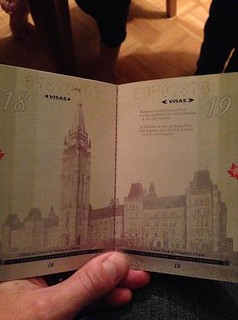
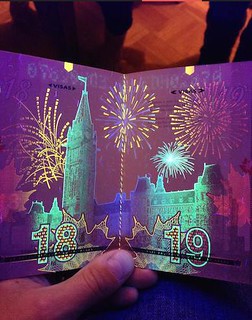
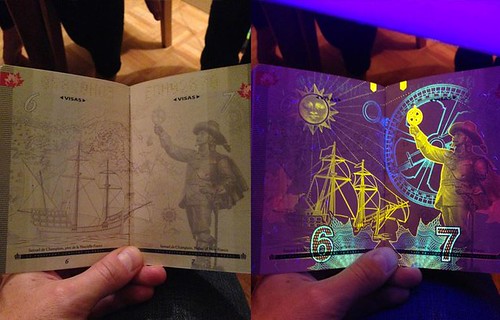
To read the complete article, see:
Canada’s New Passport Is The
Coolest In The World, Just Look At These Ultraviolet Artworks
(http://digitalsynopsis.com/design/canada-new-passport-ultraviolet-light-illustrations/#.VMXN2ksrJwk.email)
COINS FOR THE 50TH ANNIVERSARY OF THE CANADIAN FLAG

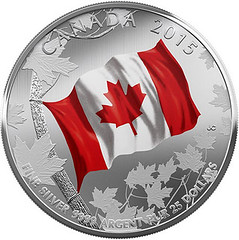
The Royal Canadian Mint have launched three new coins which celebrate and pays tribute to one of this North American country’s most treasured symbols of nationhood, that of the Canadian Flag. For many, no other symbol is as synonymous with Canada as its distinctive red-and-white flag.
As the National Flag of Canada celebrates its 50th anniversary, the nation and its people pay tribute to a beloved national symbol by proudly observing the anniversary of its official adoption. Prior to the adoption of the now iconic “Maple leaf” banner, Canada had utilized a flag with a red field along with a representation of Britain’s “Union Jack” positioned to the upper left corner and Canada’s coat of arms or, crest placed to the right of the union jack and centered. This design was adopted in 1868, shortly after Canadian Confederation and continued use, albeit with minor changes to the coat of arms, until the adoption of the recognizable maple leaf flag the world has come to associate with Canada.
The adoption of a distinct, national flag was proposed as far back as the late nineteenth century, but to no avail—that is, until the idea was raised again in 1964 by the then-Prime Minister Lester B. Pearson. After much divisive debate, the design, which was created by George Stanley and inspired by the flag of the Royal Military College of Canada (RMC) in Kingston, Ontario, was finally and officially approved by a majority of Parliament on the 15th December 1964. Elizabeth II, Queen of Canada, proclaimed the new flag on the 28th January 1965 and it was inaugurated on the 15th February the same year at an official ceremony held on Parliament Hill in the presence of Governor General, the Prime Minister, other members of the Cabinet, and Canadian parliamentarians. At the stroke of noon, the Red Ensign was lowered for the last time and the new maple leaf flag was raised. The crowd sang the national anthem “O Canada” followed by “God Save the Queen.”
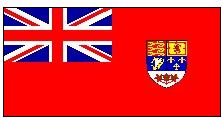 Great coins, and I do like the coloring, which is appropriate for the design and not at all gratuitous. The
Maple Leaf design has been the Canadian flag I've known all my life. I didn't know they had another one! Chip clued me in. Here's the
Canada Red Ensign Flag of 1957-1965. -Editor
Great coins, and I do like the coloring, which is appropriate for the design and not at all gratuitous. The
Maple Leaf design has been the Canadian flag I've known all my life. I didn't know they had another one! Chip clued me in. Here's the
Canada Red Ensign Flag of 1957-1965. -EditorTo read the complete article, see:
New Coins Celebrate 50th Anniversary of the
Canadian Flag (http://news.coinupdate.com/new-coins-celebrate-fiftieth-anniversary-of-the-canadian-flag-4668/)
THE BOOK BAZARRE
STARCK CONTRASTS: LIMA SHILLING, KARSHAPANA COIN
One of the great things about this job is getting to attend coin shows on a regular basis.
Of course it is always great to greet fellow collectors and Coin World readers, and meet with dealers and discuss the state of the market. From a purely selfish reason, however, it is wonderful because it means another chance to buy coins.
The New York International Numismatic Convention’s 43rd annual event, held Jan. 8 to 11, was no different.
I came home with several noteworthy acquisitions, and all have special meaning to me.
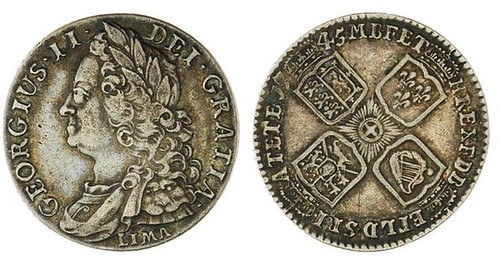
There is a romance and allure to the Lima series of coins issued in 1745 during the reign Britain’s George II.
These coins, like the shilling that I purchased, were struck from metal captured by Admiral of the Fleet George Anson in defeating the Spanish.
Having just written about these coins for Coin World’s December monthly issue, I was delighted to find one, in relatively good condition, at a price I found acceptable. And that was within the first 15 minutes of the show!
Another find was an ancient coin that I had never heard of, in a denomination worthy of a spelling bee.
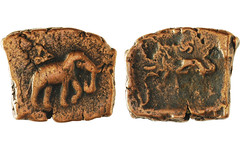 The 1.5 karshapana coin is often attributed to Pushkalavati (modern-day Peshawar) in what is
now Pakistan, and was issued sometime in the third to second century B.C.
The 1.5 karshapana coin is often attributed to Pushkalavati (modern-day Peshawar) in what is
now Pakistan, and was issued sometime in the third to second century B.C.
It wasn’t the name that drew my attention, but the square shape and the elephant on the obverse.
To read the complete article, see:
WHAT I BOUGHT AT THE 2015 NY INTERNATIONAL NUMISMATIC
CONVENTION (www.coinworld.com/voices/jeff-starck/2015/01/what_i_bought_atthe.html)
To read Jeff's tweets, see:
Results for @worldcoinguy (https://twitter.com/search?q=%40worldcoinguy%20)
CIVIL WAR SUTLER SCRIP IN STACKS BOWERS 2015 AMERICANA SALE
Lot 478: Stonewall Brigade Sutler's Tent Note
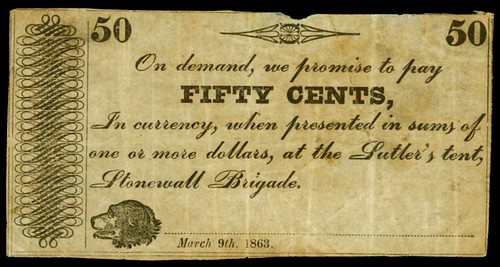
Rare and Famous Named Stonewall Brigade Sutler's Tent Note
No Location, Virginia. Charles H. Page & Co.-the Sutler's Tent, Stonewall Brigade [Army of Northern Virginia]. March 9, 1863. 50 Cents.
Fine.
Keller VA-SC050. The Plate Note. Brown paper. Left end, pattern lathe panel. Lower left dog's head. Text across center. Also listed as Jones & Littlefield PS95-05. Appears issued with a faded signature. Very Rare. Not in Ford Part X, Schingoethe Part 7, or in the 1977 Criswell Collection Sale. Up there as one of the great titles of Sutler and all American scrip notes. It is key issue for Sutler collectors and southern scrip note enthusiasts.
The brigade was named in Jackson's honor in 1863 after he was mortally wounded at Chancellorsville. It was comprised men from 2nd , 4th, 5th, 27th, and 33rd Virginia regiments that had formed up earlier in the war. The nickname given to the brigade was exclusive and official. Attractive example and formerly from the Charles Affleck Collection. He paid $100 for this from Tom Warfield and considered it a bargain many years ago. The handwritten note still comes with the note and its last sale was slightly later at the Abner Reed NASCA sale as lot 1446. We have three confirmed examples and we sold one in 2009 from the James L.D. Monroe Collection. Much paper body, but tightly trimmed. Another highlight of this memorable collection.
To read the complete lot description, see:
Rare and Famous Named Stonewall
Brigade Sutler's Tent Note (www.stacksbowers.com/BrowseAuctions/LotDetail/tabid/227/
Lot/478/AuctionID/6070/Default.aspx)
Lot 506: Johnson Island, Ohio POW Camp Sutler Note

Extremely Rare Johnson Island, Ohio POW Camp Sutler Note
Johnson Island, Ohio. [Illegible] Sutler Johnson Island. No Date. $5. Very Good.
Keller OH-SJ500. The Plate Note. White paper. Middleton, Strobridge & Co. Cincinnati. Center, horses frightened by lighting copied from obsolete notes, arched above SUTLER JOHNSON ISLAND. Lower left, seated Union and shield. Lower right, farmer with sheaf of wheat. Signature space for "Post Sutler." Very rare, but the signature is illegible due to soiling and wear.
In Keller, attributed to Moffat. However, the Wendell Wolka collection example (finest seen of the issuer) is clearly signed Chas. Maxon and appears properly accomplished. That fairly crisp note with some foxing realized $4,993.75 in April 2014 at Central States Show.
One of the most important sutler issues, north or south, as this was a POW camp used mainly for Confederate officers. Conditions here, excepting the Lake Erie winter weather, were better than most POW camps in the war. Over the course of this Sandusky Bay island's prison life, some 10,000 men passed through with as many as 3,200 populating towards the end of the war. Odd escapes of course across the ice towards Canada were attempted. The camp even hosted a few Confederate generals.
The site still exists for visitors. An important note that is all there, despite soiling, a few small flaws and thinned central patch. Flavored with Civil War history through and through. An interesting related item may be found elsewhere in this offering, where an original copy of Revised United States Army Regulations of 1861 is offered, once belonging to a sutler at Johnson's Island, E.F. Moffatt.
To read the complete lot description, see:
Extremely Rare Johnson Island, Ohio POW
Camp Sutler Note (http://www.stacksbowers.com/BrowseAuctions/LotDetail/
tabid/227/AuctionID/6070/Lot/506/Default.aspx)
Lot 538: Maryland. 3rd Regiment Maryland Volunteers. 25 Cents

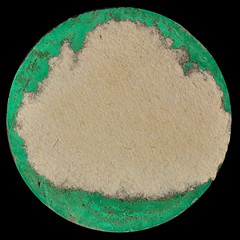
Maryland. 3rd Regiment Maryland Volunteers. 25 Cents. Green. Round. Schenkman-Unlisted. A.A. McGaffey, sutler, his name printed. Very Fine.
Lovely color and clarity and a distinctive round style. Large mount remnant on back, but of little consequence. Very rare, the issuer unlisted in Schenkman.
To read the complete lot description, see:
Maryland. 3rd Regiment Maryland
Volunteers. 25 Cents. Green. Round. (www.stacksbowers.com/BrowseAuctions/LotDetail/tabid/227/
AuctionID/6070/Lot/538/Default.aspx)
Lot 545: U.S. Colored Troops Sutler Chit

Important Southern "U.S. Colored Troops" Sutler Chit
Mississippi. 1st Mississippi Cavalry. Five Cents. Salmon. Schenkman-Unlisted. P.L. Bierce, sutler, his name printed. Very Good.
Small color losses on both sides, otherwise finer. Apparently a great rarity and incredibly historic as an issue for a "United States Colored Troops" cavalry regiment from the seceded state of Mississippi, engaged for the Union. Impressive in every respect, and unknown to Schenkman and Irons. A key piece for any advanced collection. The regiment was organized at Vicksburg, Mississippi, October 9, 1863. It served at Goodrich Landing in Louisiana, then was attached to the 1st Brigade, United States Colored Troops until March 1864, changing to 3rd U.S. Colored Cavalry on the 11th of March, 1864.
To read the complete lot description, see:
Mississippi. 1st Mississippi Cavalry.
Five Cents. Salmon. (www.stacksbowers.com/BrowseAuctions/LotDetail/tabid/227/
AuctionID/6070/Lot/545/Default.aspx)
GORNY & MOSCH AUCTION SALES 228-230
March 9-12, 2015
Gorny & Mosch
Auctions 228-230
Gorny & Mosch Presents Archaic Owls and a Collection of French Coins
Once again, Gorny & Mosch will hold its March auction week featuring coins and medals from ancient, medieval and modern times. Apart from outstanding rarities, a series of coins from the city of Athens is offered, supplemented with Russian rarities and a collection of French coin types since the French Revolution.
Immediately following the Munich Numismata, the auction of Gorny & Mosch will kick off on March 9, 2015. As always, it presents the high-quality ancient coins on the first day. Tuesday is devoted to auction #229 with further ancient coins and a large offer of multiple lots. Wednesday is reserved for the modern issues, while the Islamic and Russian coins are offered for sale on Thursday. That makes plenty of good reasons to come to Munich and participate in the auction.
Auction 228 – High-Quality Ancient Coins
The top item amongst the coins from Southern Italy and Sicily is a magnificent, attractively toned tetradrachm of the Siculo-Punians (Lot 44; estimate: 12,000 euros), with Tanit being on a par with the best of Syracusan coins in terms of the fine die cutting. Besides, the about extremely fine piece has an impressive pedigree: it had been acquired from the Italian auction house Ratto in 1945.
Anyone looking for something more special might well turn over. On the next pages he finds an extremely rare tetradrachm from Pantikapeion with the depiction of a grazing horse on the reverse (Lot 45; estimate: 15,000 euros), an excellent portrait of Philip V on one of the rarer tetradrachms of this ruler (Lot 79; estimate: 7,500 euros), an extremely rare stater of the Aetolian League with an apparently unpublished mintmark (Lot 101; estimate: 7,500 euros) and a gold drachm from Karystos on Euboia as they have been minted during the anti-Macedonian revolt from 313 B. C. (Lot 108A; estimate: 7,000 euros).
In the light that this is already spectacular, how can we describe what comes next, a series of rare Athenian tetrachdrachms dating from the Archaic Period? The top item is an early piece from around 500 to 483 that was struck on an unusually broad planchet that displays the crest of Athena’s helmet in full (Lot 111; estimate: 20,000 euros). The fine Archaic smile, however, is available for considerably less money: a roughly contemporary teradrachm on a smaller planchet but with a stylistically finer obverse die is estimated at 2,000 euros (Lot 113). Special interest is likely to be aroused by a late Classical tetradrachm that, as can be inferred from the bull’s head as mintmark, was certainly not produced in Athens but issued as an imitation possibly in Western Asia Minor or the Levant (Lot 120; estimate: 2,500 euros).
The earlier Athenian “Wappenmünzen” are secondary to the series of tetradrachms in this catalog. One discovers two didrachms (Lot 124; type: wheel; estimate: 10,000 euros – Lot 125; type: gorgoneion; estimate: 10,000 euros) and a drachm (Lot 126; type: wheel; estimate: 2,500 euros).
The most outstanding piece in the section of Asia Minor is one of the gold staters from Ephesus that have hitherto been thought to be associated with the conquest of Mithradates VI. Jenkins, on the other hand, was able to prove that the first ones of these have actually been minted at a much earlier date. Having said that, the extremely fine stater that features the Greek Artemis on its obverse and the Artemis of Asia Minor on its reverse still is an icon of the coinage of Asia Minor (Lot 144; estimate: 25,000 euros).
Anyone interested in the ancient coinage of the Near East might start saving up money. Two very rare tetradrachms from the Seleucid province Persis in finest condition are on offer. The first is a tetradrachm of Baydad, who became satrap of the province Persis shortly before 300 B. C., as the first indigenous Persian ever (Lot 176; estimate: 12,000 euros), the second is the same nomination of his distant successor called Vadfradad II dating from the first half of the 2nd century B. C., who refers to himself on his coin as frataraka, keeper of the fire, a high title in Zoroastrianism.
In 238 AD, the Parthians conquered the major part of the Persis. Of conqueror Shapur Gorny & Mosch offers an extremely fine dold dinar (Lot 181; estimate: 12,000 euros). Almost equally as rare is the gold stater of Vahran II (Lot 182; estimate: 10,000 euros). A great rarity is hidden amongst the Greek coins from Roman imperial times: a drachm bearing the portraits of the Armenian king and Augustus, token of a short-lived agreement between Armenia and the Roman Empire (Lot 199; estimate: 17,000 euros).
With this, we have arrived at Rome. When it comes to this section, auction #228 leaves nothing to be desired: gold, silver, bronze, a large collection of coins from the Roman Republic including many rarities – every aficionado of the Romans will find something to his liking.
Let us start with the large series of aurei: there are the ones of Tiberius (Lot 562; EF; estimate: 7,000 euros), for example, and of Commodus (Lot 638; FDC; estimate: 35,000 euros), Philipp I (Lot 669; EF; estimate: 25,000 euros), Hostilian (Lot 674; EF+; estimate: 25,000 euros) or of Trebonianus Gallus (Lot 767; FDC; estimate: 25,000 euros).
To anyone more fond of bronze coins we recommend the sestertius of Claudius (Lot 576; EF; estimate: 8,000 euros), the sestertius of Vespasian (Lot 595; EF+; estimate: 5,000 euros) or the bimetallic medallion of Philip I (Lot 670; VF; estimate: 8,500 euros).
There are some particular rarities available for the admirers of Late Rome and Byzantium, like a solidus of Glycerius (Lot 727; about EF; estimate: 30,000 euros), a solidus of Michael III (Lot 768; EF+; estimate: 14,000 euros) and an unpublished gold bulla in the weight of two solidi of John I Tsimiskes (Lot 770; VF; estimate: 40,000 euros).
Auction 229 – Ancient Coins and Multiple Lots
More ancient coins are to be found in catalog 229. They will be auctioned on the second day of the auction week. Here, too, the aficionado discovers coins of the Celts, the Greeks, the Romans and the Byzantines as well as the famous multiple lots that virtually enjoy cult status in Munich. He who collects ancient coins can enter the bidding in the two-digit region.
As always, the many interesting bronze coins are remarkable, as is the large series of fractions, including numerous unpublished specimens. It is clear to see that it still does not take a great deal of money to assemble a thrilling collection of ancient coins.
Amongst the Romans, the connoisseur finds several historically telling reverse depictions, like an aureus of Caracalla, whose reverse shows a sacrifice in front of the Temple of Vesta (Lot 1761; VF; estimate: 2,500 euros).
Auction 230 – Medieval and Modern Issues / Collection France and Colonies / Collection Russia
As is tradition, the auction is concluded by coins and medals from medieval and modern times. It all starts with German coins featuring several rarities, like a very rare thaler of Frederick William, Elector of Brandenburg, from 1675 on the victory at Fehrbellin (Lot 3050; EF; estimate: 3,000 euros) or a reichsdoppelthaler from 1592 of Georg Friedrich of Brandenburg-Ansbach for Silesia-Jägerndorf (Lot 3230; EF; estimate: 5,000 euros). The medals include a small collection of religious medals.
The centerpiece of the European coins and medals is an almost complete collection of French coin types since 1789 as well as some coins struck in German under French occupation and a set of Monégasque coin types. Next in line is a separate although incomplete collection of coins from the French colonies which gives the francophile collector quite a lot to choose from. To single out just a few specimens: a rare 2 francs piece of Napoleon I from 1807 on which the emperor does not wear a laurel wreath (Lot 3478; VF; estimate: 2,000 euros) and a rare 2 francs piece that was minted during the Hundred Days (Lot 3496; VF; estimate: 500 euros). Only 3,972 specimens were struck of an offered 10 centimes piece in 1914 (Lot 3575; FDC; estimate: 2,000 euros).
Those who are enthusiastic about faraway places will appreciate the series of extremely rare fractions covering 25, 20 and 5 centimes from 1943 produced in the Pretoria Mint for Equatorial Africa (Lot 3587; about FDC; estimate: 2,000 euros), just as the, in this condition very rare, 1/2 cent piece for Indochina in tin from 1939 (Lot 3596; FDC; estimate: 1,000 euros).
Under Serbia only two lots can be found, but they are of great rarity: a 5 dinar 1879 of Milan IV / I Obrenovic, minted in Vienna in 1879 (Lot 3772; Proof; estimate: 5,000 euros) and a set of fractions of both 2 and 1 dinar as well 50 para, produced in Vienna in the same year (Lot 3773; Mint State; estimate: 1,400 euros).
Likewise remarkable are the more than 104 multiple lots containing more than 4,200 coins in total. Viewing them pays off for some thrilling material is hidden there. For example: what might be the story of the 181 coins that traveled as ship coinage from the New World to Spain in the 16th/17th centuries? (Lot 3973; 181 specs.; estimate: 5,000 euros).
Next are the Islamic coins with a large series of Ottoman specimens. Many a discovery can still be made there: the range of offers include, for example, an unpublished unique specimen of Osman III, a sutani altin 1168 H. (1755) made in the Tarablus Mint (Lot 4275; estimate: 1,500 euros) or an extremely rare 1 1/2 altin 1187 H. (1773), a Misr Ziynet coinage following the Istanbul model (Lot 4285; estimate: 1,000 euros).
To conclude this preview, let us have a look at the large series Russia where the great number of gold and silver coins contains numerous medals of great historical interest, like a medal of Alexander II for Finland from 1857 on the 700th anniversary of the introduction of Christianity to Finland (Lot 5218; estimate: 1,000 euros). The rarest coin of the Russian section is a 5 kopeck piece from 1860 produced in the St. Petersburg Mint (Lot 5215; estimate: 20,000 euros). The highest pre-sale estimate has an undated Order of the White Eagle with a marvelous overall appearance (Lot 5261; estimate: 25,000 euros).
All auction sale catalogs can be viewed on the internet at http://www.gmcoinart.de/online_katalog and ordered at Gorny & Mosch, Giessener Münzhandlung, Maximiliansplatz 20, D-80333 Munich, phone +49 / (0)89 / 24 22 643-0, fax +49 / (0)89 / 22 85 513.
Lot 44: SICULO-PUNIANS (Sicily). Tetradrachm
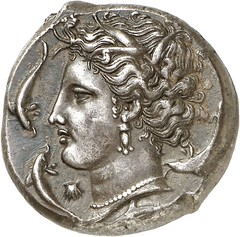
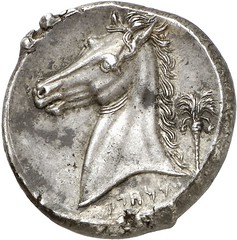
Lot 44: SICULO-PUNIANS (Sicily). Tetradrachm, 320-310. Acquired from Ratto in 1945. Marvelous style! About extremely fine. Estimate: 12,000,- euros
Lot 45: PANTIKAPEION (Taurian Chersonese). Tetradrachm
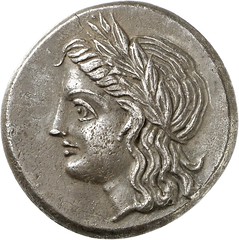
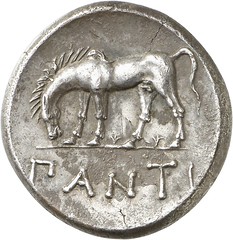
Lot 45: PANTIKAPEION (Taurian Chersonese). Tetradrachm, 355-320. Ex Gorny & Mosch 146 (2006), 84. Very rare. Extremely fine. Estimate: 15,000,- euros
Lot 576: CLAUDIUS, Sestertius
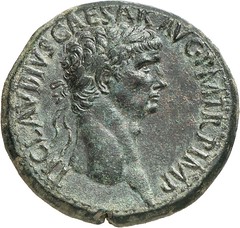
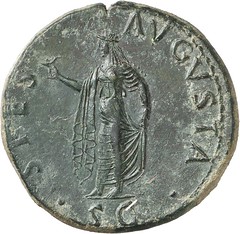
Lot 576: CLAUDIUS, 41-54. Sestertius, 41-42. Rev. SPES AVGVSTA / SC Spes. Extremely fine. Estimate: 8,000,- euros
Lot 3797: HUNGARY Gold gulden 1704
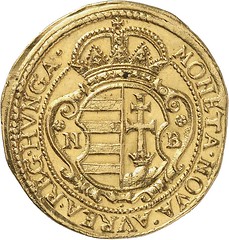
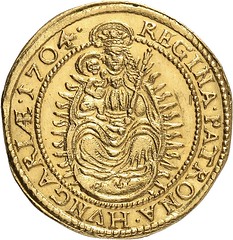
Lot 3797: HUNGARY. Francis II Rakoczi and the Malcontents, 1703-1711. Gold gulden 1704 NB, Nagybanya. Auction Dorotheum 938 (2013), 47-16968. Very rare. About brilliant uncirculated. Estimate: 3,000,- euros
Lot 5138: RUSSIA. Paul I Ducat 1797
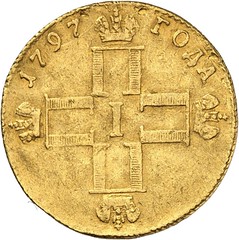

Lot 5138: RUSSIA. Paul I, 1796-1801. Ducat 1797 SM-GL, St. Petersburg. Rare. Very fine. Estimate: 4,000,- euros
Lot 5218: RUSSIA. Alexander II Medal 1857
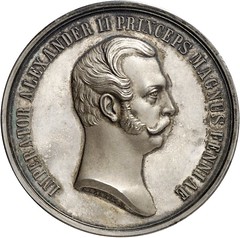
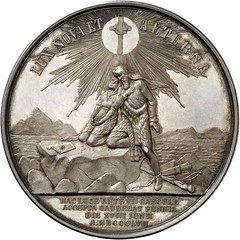
Lot 5218: RUSSIA. Alexander II, 1855-1811 for Finland. Medal 1857 of A. Lyalin / M. Kuchkin on the 700th anniversary of the introduction of Christianity to Finland. Rare. Extremely fine to brilliant uncirculated. Estimate: 1,000,- euros

COIN SAVED SOLDIER'S LIFE AT BATTLE OF WATERLOO
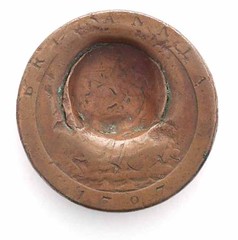 A penny that saved the life of a British soldier at Waterloo by intercepting a French musket-ball is among
dozens of artefacts in a new collection created to mark the 200th anniversary of the Battle of Waterloo. The George III 'cartwheel penny' was
unusually large and thick and came in very handy for one British soldier.
A penny that saved the life of a British soldier at Waterloo by intercepting a French musket-ball is among
dozens of artefacts in a new collection created to mark the 200th anniversary of the Battle of Waterloo. The George III 'cartwheel penny' was
unusually large and thick and came in very handy for one British soldier.
This features in an online gallery of 200 items assembled for the launch of a website to commemorate the bicentenary of the clash between the two generals' armies in June 1815. The exhibition also includes a field surgeon's blood-stained equipment and an eagle standard taken from the French army after their defeat, as well as a number of objects that have never been on public view. The haul has been drawn from the National Army Museum's Waterloo Collection, loans from museums across Europe and private collections, and the artefacts relate to participants on both sides of the conflict, ranging from regular infantrymen to high-ranking officers.
To read the complete article, see:
Battle
of Waterloo artefacts: See the coin that saved a soldier's life
(www.telegraph.co.uk/news/picturegalleries/uknews/11372322/Battle-of-Waterloo-artefacts-See-the-coin-that-saved-a-soldiers-life.html)
GOLD NUGGETS STOLEN FROM WELLS FARGO HISTORY MUSEUM
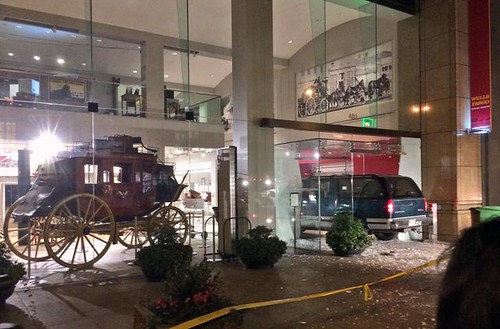
Thieves rammed a stolen SUV into a downtown San Francisco museum early Tuesday and swiped historic gold nuggets in the latest smash-and-grab theft in the area in recent months.
Three masked men jumped from a Chevrolet Suburban after it rammed through a revolving door at the Wells Fargo History Museum in the financial district and held a security guard at gunpoint while taking gold nuggets from a display case.
The three men escaped in a four-door sedan driven by an accomplice. The security guard was unharmed.
The tactic mirrored three other smash-and-grab thefts involving vehicles in the San Francisco Bay Area since May. Police said they are investigating whether there's a connection.
Police did not reveal the value of the stolen merchandise in any of the cases.
As many as 10 ounces of gold with an estimated value of roughly $10,000 was stolen from the Wells Fargo museum. Wells Fargo officials were still trying to determine exactly what was stolen before determining a more precise loss figure.
Dealers of precious metals say they will be on the lookout for nuggets with historical significance that suddenly appear on the market, rare coin dealer Don Kagin said.
Melting the precious metal could remove possible markings concerning when and where the nuggets were mined, said Fred Holabird, a mining geologist and an owner of a rare and unique collectibles business in Reno, Nevada.
"This is such bad news from my viewpoint," he said, calling the potential loss of historical indicators a tragedy.
Holabird said the nuggets could be worth two to 10 times the value of gold now selling for about $1,300 an ounce on the open market.
Wells Fargo spokesman Ruben Pulido said in a statement that the company is grateful that no one was injured and no damage was done to the historic stagecoaches at the site where Wells Fargo launched in 1852.
To read the complete article, see:
Thieves smash stolen SUV into San Francisco
museum for gold (www.wral.com/gold-nuggets-stolen-from-wells-fargo-museum-in-san-francisco/14394377/)
MASSIVE FIRE AT A MOSCOW SCIENCE LIBRARY
 A fire that ripped through one of Russia's largest university libraries
is believed to have damaged over one million historic documents, with some describing the fire as a cultural "Chernobyl."
A fire that ripped through one of Russia's largest university libraries
is believed to have damaged over one million historic documents, with some describing the fire as a cultural "Chernobyl."
The blaze, which started Friday and was still not completely out on Saturday evening, ravaged 2,000 square metres (21,500 square feet) of the Institute of Scientific Information on Social Sciences (INION), which was created in 1918 and holds 10 million documents with some dating back to the 16th century.
"It's a major loss for science. This is the largest collection of its kind in the world, probably equivalent to the (United States) Library of Congress," Vladimir Fortov, president of the Russian Academy of Sciences was quoted as saying by Russia press agencies.
"One can find documents there that are impossible to find elsewhere, all the social sciences use this library. What has happened here is reminiscent of Chernobyl," he said referring to the 1986 nuclear catastrophe.
Fortov said about 15 percent of the collection had been damaged at the library, which includes one of the world's richest collections of Slavic language works, but also documents from Britain, Italy and the US.
The fire broke on Friday evening on the library's second floor and continued burning all day Saturday despite 200 firefighters efforts to douse the blaze.
To read the complete article, see:
A
million documents, some dating back to the 16th century, damaged in Russian library blaze
(http://artdaily.com/news/76153/A-million-documents--some-dating-back-to-the-16th-century--damaged-in-Russian-library-blaze#.VM5G_WgVi5U)
THE BOOK BAZARRE
ROYAL MINT'S 5P AND 10P COINS STILL CAUSING PROBLEMS
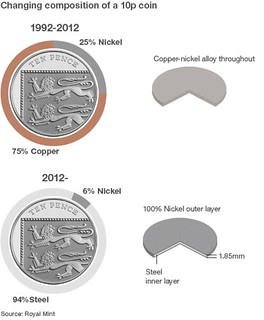 Passengers
have slammed train operator Southeastern for increasing car parking charges by 10p - even though its machines do not take new 10p coins.
Passengers
have slammed train operator Southeastern for increasing car parking charges by 10p - even though its machines do not take new 10p coins.
The problem came to light after William Wood, of Etchingham, had problems at Etchingham railway station.
He used to pay £4 using pound coins but after the charges went up to £4.10 he discovered the machines did not work.
Southeastern, which covers Kent and Sussex, has apologised for difficulties faced by Mr Wood and other passengers.
Southeastern said it brought in a 10p rise for all its car parks, but after the increase came into effect its parking machine supplier notified the rail operator new 10p and 5p coins would not work.
he company said it was working with its supplier to resolve the issue and added: "In the meantime, passengers are able to pay online through our website, at ticket offices and via mobile."
Royal Mint said the cost of raw materials had escalated and it had been necessary to reduce the cost of producing coins and increasing wear-resistance.
Since January 2012, all new 5p and 10p coins have been made from nickel-plated steel.
Royal Mint said bulk samples were provided to the vending machine industry well in advance of the rollout to allow calibration of machines.
To read the complete article, see:
Southeastern apologises for parking machine problems
(www.bbc.com/news/uk-england-31034905)
NEW BRITISH ONE POUND COIN VEXES VENDING INDUSTRY
It has been announced as the safest coin of the world: Great Britain’s forthcoming £1 coin. The only safe thing to say until now is that the industry will face eight-figure costs. Because all machines in the UK which accept coins must be modified: estimated 450,000 vending machines, 100,000 parking machines, 60,000 payphones, and even the shopping trolleys in the supermarkets.
The last time such an effort had to be undertaken was in 2012 when new 5 and 10 pence pieces were introduced. Then, according to the Automatic Vending Association (AVA) the association spent £25 million for adapting all machines. Today it may cost even more, the sum of £50 million was mentioned. The Royal Mint, though, expects the costs to be clearly lower ranging between £15 to £20 million.
Additionally, in 2012 the industry deplored that the requested conversion had to be undertaken at a short notification. This time, however, a longer transition period of three years has been deliberately conceded.
On their website the association welcomes the introduction of a new and safer coin demanding a close cooperation between The Mint, The Treasury, and the industry in order to ensure a shift as smooth as possible.
The new £1 coin is scheduled to be put into circulation in 2017. The coin will have a 12-sided shape like the former 3 pence piece. But, above all, the hightech coin will contain cutting-edge security features. This was imperative because approximately 3 per cent of all £1 coins currently in circulation are considered to be fake.
To read the complete article, see:
Vending machine industry will pay dearly for new British coin
(www.coinsweekly.com/en/News/4?&id=3232)
COUNTERFEIT DETECTION BY BITING
Fred Michaelson writes:
I was just watching an episode of Amos 'n Andy, which I think is the funniest thing that's ever been on TV. In this episode, Andy and the Kingfish have a parking lot. Each time a customer pays, the Kingfish puts the coin between his teeth and appears to bite it before he puts it in the cash register. Is this some old method of counterfeit detection?
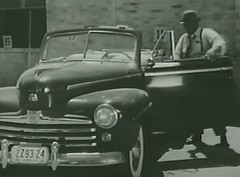

To watch the complete episode, see:
Amos 'n' Andy Season 2 Full Episode 23 - Leroy Lends a Hand
(www.youtube.com/watch?v=tEnDhU_8fmw)
THE BOOK BAZARRE
HEY KIDS, WANT TO COUNTERFEIT MONEY?
This is the latest in a series (of indefinite length and regularity) of pieces looking at advertisements in comic books over the decades that amused me for whatever reason. Today we look at a tool for kids to make their own money.
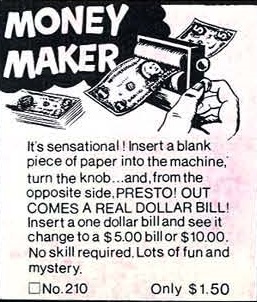
I imagine that the gag is that you have a pre-loaded bill and then you put a blank piece of paper and “roll” the blank piece of paper into the dollar bill. But I’m sure hundreds of would-be counterfeiters sent in their hard-earned cash to see if it was something better!
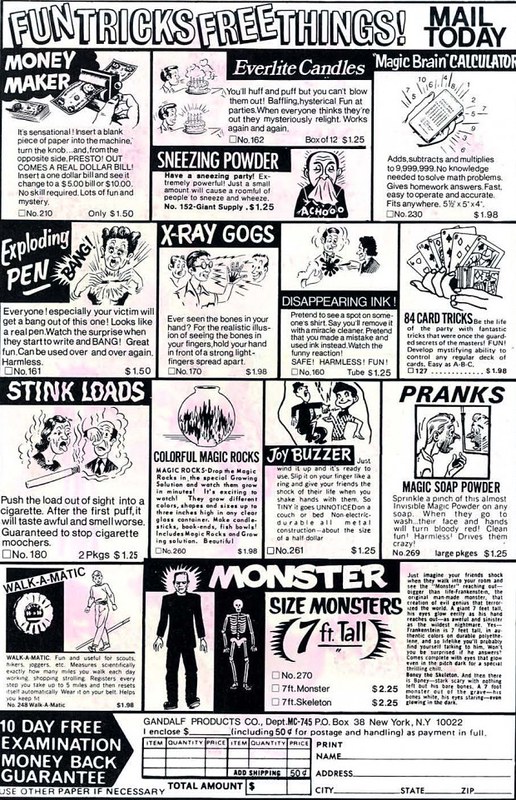
To read the complete article, see:
I Saw It Advertised One
Day – Hey Kids, Want to Counterfeit Money?
(http://goodcomics.comicbookresources.com/2015/01/29/i-saw-it-advertised-one-day-hey-kids-want-to-counterfeit-money/)
FAKE BANKNOTE GIVES WOMAN A HEART ATTACK
 A woman in
northeastern China suffered a heart attack after a taxi driver slipped a worthless “ghost bank note” in her change, mainland media reports.
A woman in
northeastern China suffered a heart attack after a taxi driver slipped a worthless “ghost bank note” in her change, mainland media reports.
The woman, surnamed Sun, from Harbin, capital of Heilongjiang province, told local newspaper Life News that she paid the driver a 100-yuan bill (HK$126) late at night earlier this month. The driver, whom she described as “at about 30, with cropped hair, very thin face and weak voice”, gave her 85 yuan in change, including a 50-yuan bill.
It was dark and freezing so Sun quickly put the money in her purse. Later at home, she discovered the 50-yuan bill, which was green like the real things, was ghost money used as offerings to the dead.
Made of low-quality paper, ghost bills sometimes resemble Renminbi.
Sun, upset about by the deception, suffered a heart attack later that night and was admitted to hospital.
Heilongjiang TV reported two similar cases in the city.
To read the complete article, see:
Taxi passenger
suffers heart attack after being given ‘hell bank note’ in change
(www.scmp.com/news/china-insider/article/1692119/taxi-passenger-suffers-heart-attack-after-being-given-hell-bank)
THE GROUNDHOG DAY MARATHON MEDAL

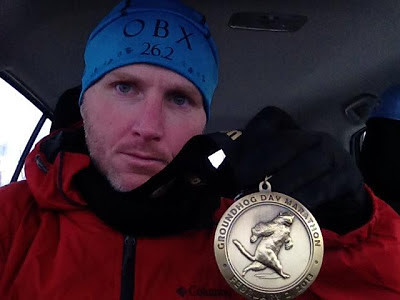
To read the complete article, see:
Sidelined Again - Ice is Slippery
(http://sandyruns.blogspot.com/2013/02/sidelined-again-ice-is-slippery.html)
For more information on Groundhog Day, see:
www.groundhog.org
FEATURED WEB PAGE: CURRENCY PATENTS
This week's Featured Web Page is the currency patent search tool on the Counting On Currency web site.Counting On Currency offers a customized search tool for currency patents. There is a Currency Patents menu item on the site that presents a list of various search terms like "banknote" and "coin". When the search term is clicked a page will be displayed containing a list of patents related to the search term. Visitors can revise or refine the search criteria to find the specific patent(s) they seek.

http://countingoncurrency.com/
